#Henry HAD held parliaments outside of London before
Explore tagged Tumblr posts
Text
I wanted to make a more detailed post on Henry VI, but going by my record of unfinished posts, that's probably not going to happen anytime soon :( So here's another small excerpt from a contemporary letter which I think is very revealing, and which I personally haven't ever seen historians quote before.
From Ghent, on the 4th of April 1461 (CSPM):
"The king here [Henry VI] ordered King Edward as a traitor and rebel to the crown to return to his obedience. King Edward replied that he was no traitor, but the rightful king, and if he came to show obedience he would leave something to be remembered. For this the king here [Henry] had the messenger beheaded. The new king, enraged at this act, promised to have the noblest head from among the king's followers."
...This is a very different image of Henry VI and his role in the Wars than what we're used to seeing, both in general histories of the period and in pop culture-esque media. What is presented here is a power play between two kings, and Henry was clearly the one in charge of his own side: he declared his rival king a traitor, ordered him to return to obedience, and beheaded the royal messenger as a symbolic and literal punishment. While the Yorkists may have framed Henry as, in the words of George Neville, "a puppet of a king", trying to downplay his role for their own political benefit, reports like this give us the clear impression that their claims seem to have been very different from reality.
We don't objectively know if this incident actually happened, though it most likely did. But as I mentioned earlier, what's more important is what it tells us about the impression contemporaries actually had of Henry VI's role. It's a far cry from the popular idea of a "role-reversal" between him and Queen Margaret: the image of her as a figure of superior authority taking charge of a passive and incapable Henry is non-existent in this letter, which instead shows Henry as the decision-maker. Again, if Margaret was truly believed to be the one in charge, contemporaries would have surely drawn attention to her: they had no problem emphasizing her role during Henry's capture in 1460, or when they were separated in the decade after. When they were specifically together, however, sources like these give us a different impression. This matches the letters I quoted earlier about Berwick and indicates that contemporaries reporting ongoing events clearly regarded Henry as the active leader of his side. (What you think of his actual capabilities or the wisdom of his decisions is not relevant).
Here's another example that shows us that Henry was perceived as being clearly involved in resistance to Yorkist rule. It's about the conspiracy backed by the Earl of Oxford in 1464, which was quickly foiled by the Yorkists and led to a bunch of people getting their heads chopped off. It's written by Antonio Della Torre, Edward IV and Warwick's own envoy:
"Their plan was as follows : to follow the king [Edward] as his servants towards the North, as his Majesty was not going to take more than a thousand horse and their two thousand or more, and once among the enemy they were to attack the king and murder him and all his followers . In the mean time the Duke of Somerset, who was at Bruges and is still there, was to descend upon England, and King Henry was also to come with the Scots, and the Earl of Pembroke from Britanny."
We get a similar impression as the ones above. The idea that Henry was sitting passively and doing nothing while his queen and allies tried to win back his throne for him just doesn't hold up: Edward IV's own envoy tells us that he, Somerset and Jasper Tudor were working together to try and take down the Yorkists and were coordinating an attack that they would all (including Henry in his own right) be involved in. Again, away from Yorkist propaganda which de-emphasized his role for their own political purposes, Henry's role and involvement as King (or deposed King trying to win back his throne) was demonstrably recognized by most contemporaries.
In general, I think historians tend to gloss over primary sources like this because they're more "standard". Henry's doing what he (by the requirements of his time period) "should" be doing, and so it's not viewed as provocative or worthy of mention. But that's exactly why it should be highlighted more. When we speak of Henry's illnesses, of his capture in 1460 and post 1465, of his role after he was technically released in 1470-71 (I say technically because he was under the Nevilles' control during that time), we're speaking of very unique situations which cannot be used to extrapolate his role and actions, or Margaret of Anjou's role and actions, or their political dynamic with each other (ie: a "role-reversal"), under more "ordinary" circumstances. Sources like these are the ones that matter far more in that aspect.
*Two other things to point out:
Re the idea of Henry being a "puppet of a king": the fact of the matter is that his enemies had very real political reasons such framing him in such a manner; their claims can't necessarily be taken at face-value and viewed as the default "truth" about Henry's actual role and involvement in politics at the time. This applies for 1461-65 and also for the late 1450s (where government records prove without a doubt that Henry VI was involved in ruling the country, while being heavily advised/handheld by his council and advisors. Things like Loveday, and the Yorkist trial referenced in the 1459 attainder, also make it clear that he was ultimately the one deciding policies towards the Yorkists. I do think Margaret became more active in asserting royal interests - their letters in support of John Hals make it clear - and she was involved in running the crown prince's lands, but I'm not sure we can unquestionably claim that there was some kind of "role-reversal" between them, or that Margaret was actually the one ruling England and deciding policies, during that time. Ultimately, it's a lot more speculative and uncertain than that - and Henry was nowhere near as inactive as is often assumed. Evidence is clear that he did make decisions and involve himself in administration and military. And if this is the case - which it is - then the question arises: what was the point of a role reversal in the first place? Margaret is usually credited with assuming leadership because of a passive and ineot Henry, but we now know that he was not passive. So we can and should question the idea of her needing to take charge at all.
While this narrative of passivity has stuck the most with Henry VI, it's important to remember that he was far from the only King to be framed in such a manner. Mang others were as well, in different-yet-ultimately-similar ways. Like I said, it was a very convenient narrative to use by political enemies to downplay and diminish the position and authority of the king when they were trying to oppose him. For Henry, he's also affected by the fact that 1) he ultimately lost his throne twice, 2) he was constrained and controlled by York on different occasions in the late 1450s and by the Nevilles in 1470-71, 3), he was out of action from late 1460 to early 1461 and from 1465-70, which made Margaret take the leading role in the Lancastrian cause, and 4) Tudor efforts to promote his piety and canonize him as a saint relied on narratives of passivity rather than action. Put together, the way Henry viewed in general histories, though frustrating, is not especially surprising. However, to get a better picture of his actions when he actually was capable of making them, and to understand how his role was actually perceived by contemporaries away from Yorkist propaganda, these few excerpts I've posted are probably some of the most reliable sources we have.
...This was supposed to be just a few paragraphs long, rip. But either way - this is just my own analysis & opinion, feel free to agree or disagree (or both!). But I thought these few things were worth pointing out - at least, they definitely gave me a very different impression of Henry's - and by extension Margaret's - role in the early 1460s, which can perhaps also be considered when analyzing them in the late 1450s as well :)
Friendly reminder that Francesco Coppino and Prospero di Camulio, contemporaries who were literally getting their information from predominantly Yorkist circles, were both explicitly clear that it was Henry VI who decided to surrender Berwick to Scotland.
Camulio: "King Henry has given away a castle [town] called Berwick, which is one of the keys of the frontier between England and Scotland." Coppino: "[Scotland has] received from the same Henry the town of Berwick, on the frontiers of Scotland, which the Scots have long claimed as their right from the English, as the excellently well furnished guardian of their frontiers, and the place to which King Henry repaired as an asylum after the battle."
The idea that Margaret of Anjou was principally involved in the surrender, or that she was the one who actually made the decision, is based on nothing but assumption. Two direct contemporaries, both speaking of ongoing events as they unfolded, who were both getting information from Yorkist-held England, both clearly believed it was Henry who was responsible for this course of action. Neither of them mention Margaret. Sure, you can argue that it was merely rhetorical, and that they were simply automatically attributing such an important decision to the King rather than the queen - but rhetoric is nonetheless extremely important and helps us understand how historical figures were perceived at the time. Margaret's enemies would surely not have hesitated to broadcast her involvement had it actually been true, and Coppino in particular had shown no qualms about criticizing her in favor of the Yorkists before. If she was genuinely believed to have been responsible, and if the Yorkists were actually claiming that she was at the time, I see no reason why Coppino or Camulio would not have emphasized her role in their letters. What these samples instead indicate is literally the opposite: that their contemporaries - probably including the Yorkists who were putting out the information that Coppino and Camulio reported - actually believed that Henry was the one making the decision. I think it's a very large and very unnecessary stretch to go against actual evidence and claim otherwise by placing the responsibility on Margaret instead.
Additionally, these small samples may also reveal what people at the time - once again including the Yorkists - actually thought of Henry's role in the war on a broader level, away from direct Yorkist propaganda which would obviously and perhaps understandably seek to de-emphasize it: namely, that Henry was perceived as the one making decisions and deciding the courses of action for his own side.
Source: Excerpts from the Calendar of State Papers and Manuscripts, Existing in the Archives and Collections of Milan
#henry vi#my post#margaret of anjou#(kinda?)#I also wanted to talk about Thomas Gascoigne - whose account of Margaret's political dominance in 1456#is often quoted by historians but which we should be very wary of accepting at face-value#not just because Gascoigne favored York and may well have been repeating York's own slander at the time#(he repeatedly says 'as it is said' - WHO is saying this? Most of the nobility supported Henry none of them would have said this)#but also because ... his account is demonstrably unreliable and far too hysterical to take seriously#like he complains about Margaret's paltry dowry THREE TIMES my god you'd think the guy would have something better to do with his life#but more importantly:#he claims that Margaret had drawn the king and prince to her house in Chester so that she would manage all business of the realm#which is not true at all#Margaret did not 'draw' her son anywhere and certainly not for her own benefit#he was the crown prince and was given his own council and lands as most other crown princes had been given during their time#it was far more 'typical' and precedented situation than Gascoigne makes it out to seem#I should also point out that while retreating and setting up a base in the Midlands was really not ideal - certainly at that point in time#and for so many months on end - it wasn't as unusual as some historians have made it out to seem#Henry HAD held parliaments outside of London before#and it seems the decision to move to the Midlands was actually very last minute - as late as September there's evidence he#was planning to gather his great council in London#I should also point out that while it's often claimed that Henry stayed in the Midlands throughout the late 1450s...he *didn't*.#He actually returned to the Home Counties in September 1457 and stayed there for many months#(as far as I know Margaret remained in the Midlands. Again the impression you get is that he wasn't really reliant on her to rule for him)#the situation really does not seem to be as simple as Margaret deciding they should move to the Midlands and Henry complying#she may have encouraged; she may have been relieved; she may have genuinely disliked London;#but as of September Henry was still planning to conduct the meeting in the capital#so the situation was nowhere near as straightforward or simple as that but instead seems to have been more improvised#again - I'm not trying to downplay Margaret's role i do think she was involved. I just think that the idea of a 'role-reversal' is far less#likely and far more uncertain than is assumed - and Henry's own involvement is certainly very overlooked throughout it all)
17 notes
·
View notes
Text
ON THIS DAY - 04 Nov 1605
On This Day (04 Nov) in 1605, Thomas Percy, one of the known conspirators of the 'Gunpowder Plot' visited his distant cousin and employer Henry Percy, 9th Earl of Northumberland at Syon House, his primary residence 10 miles outside London.
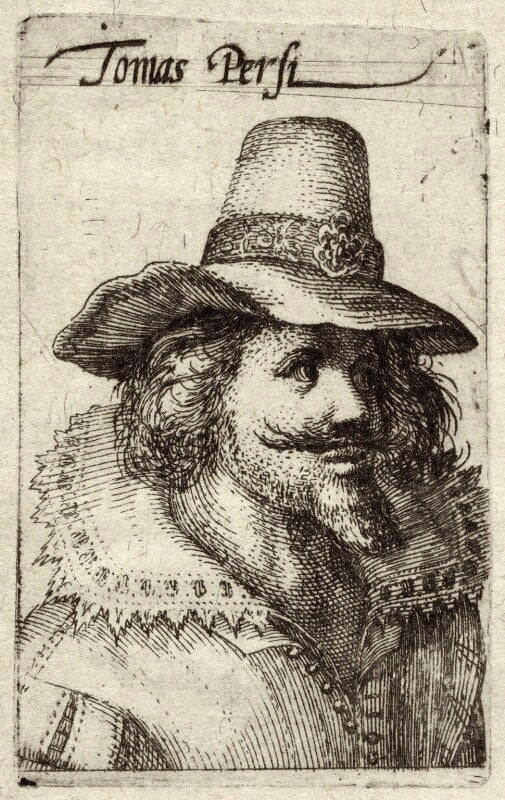
Percy was one of the 13 co-conspirators of the 'Powder Treason': a regicidal plot masterminded by Robert Catesby, a disillusioned Catholic, who planned to blow up the State Opening of Parliament, at which James I and his heir Prince Henry, was due to be present, and to abduct his young daughter Princess Elizabeth, and proclaim her queen.
Percy visited Syon regularly on business, having been appointed by the Earl to manage his northern estates; however, it has been speculated that the reason for this particular visit was to scope out as to whether his cousin had heard any news of the planned plot (as the conspirators had been made away of the 'Monteagle Letter' - a warning letter sent to Catholic peer William Parker, Baron Monteagle).
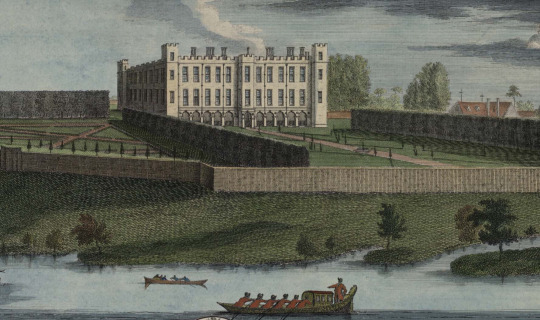
Also present was Thomas Harriot, mathematician, scholar and astronomer, who was living at Syon under the patronage of the Earl. Harriot would later give evidence confirming that there had been no discussion of the plot or the death of the King at their lunch.
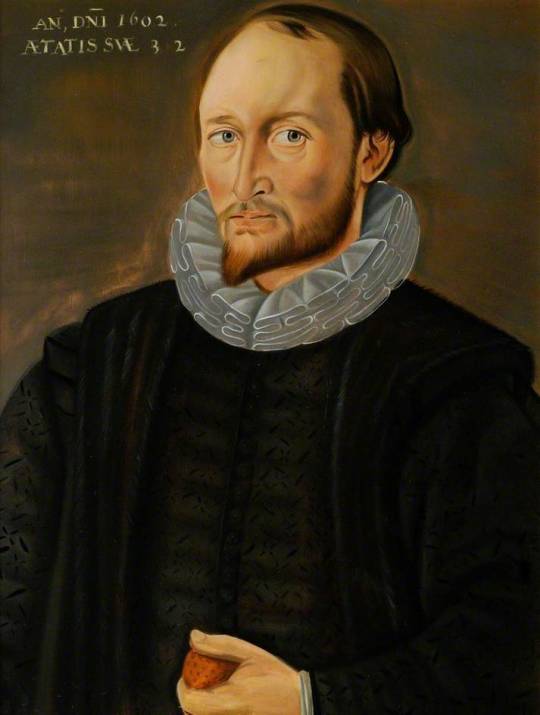
Following dining at Syon, Percy was known to have visited Essex House on the Strand, where the Earl's brothers were residing. After this, Percy was said to have met up with some of his fellow plotters, before returning to his lodgings, awaiting the planned events of the following day.
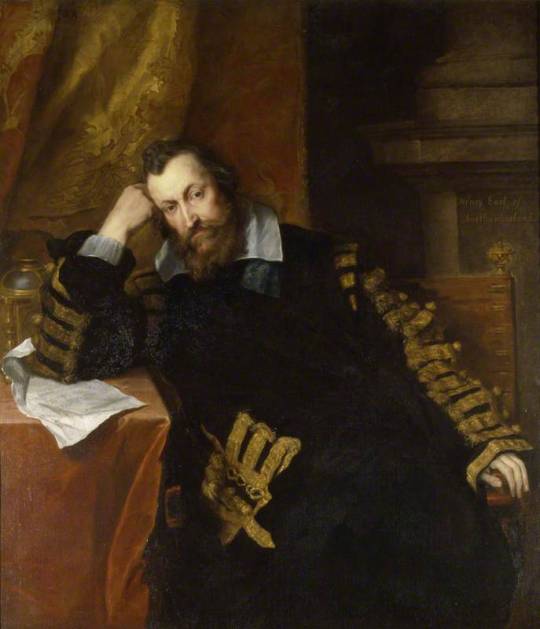
Percy's actions this day had significant consequences for the Earl. Initially placed under house arrest on 07 Nov, Henry Percy was arrested on 27 Nov and placed in the Tower of London, accused of misprision - that he was aware of the plot and did not inform the authorities. There was not enough evidence to convict him for this; however, he was charged with contempt, stripped of his titles, fined and held in the Tower for a further 16 years.
#history#gunpowder plot#powder treason#Henry percy#Thomas percy#syon house#Thomas harriot#Robert catesby#guido fawkes#tower of london
0 notes
Text
attended to his letters; a course of reducing exercises
or did you hear commentaries [ ] over the radio? I don’t have the time to do it. You don’t have time to do it. 1 and that, of course, you don’t have time to was taught the game 2 increasing the feed for / my dope, but you don’t have time 3 You don’t have time to investigate them fully yourself? No 4 It was hard work? — Yes, sir. You have to be fast and do the best you can. You don’t have time 5 for nearly everything; you don’t have time 6 You don’t have time to bother about your neighbors, and you don’t 7 enjoy our own com . pany , as we never have any chance to see friends around home, for you don’t have time after and before 8 And in some cases wastefully? — Not wastefully. Does not one involve the other? — I don’t see it in that light. A man applies for relief. You don’t have time to see that man. 9 you don’t have time to spend one hour in thinking every day to see your business in a bigger, better, and cleaner way than it is today. [ ] desk covered with papers, unfinished business, no time to see 10 the “ticket” for large swamps. You don’t have time 11 You see, when you’re on the news end of a thing like this you don’t have time to get worked up. 12 “Well,” she said, “I suppose you are so busy at the office you don’t have time. 13 you are so terribly busy that I suppose you don’t have time to feel lonesome. Why can’t girls do something like that, too? 14 “How did you like it down there?” he asked. “Well” — she paused thoughtfully — “down there you can keep busy. There’s something to do all the time; you can keep so occupied that you don’t have time to stop and think and feel.” 15 you don’t have time to think of danger” But one foggy morning not long after... 16 today. always say you don’t have time to read. ward, like a girl 17 By the time he had days. When you’re busy you don’t have time to attended to his letters. 18 a course of reducing exercises, you don’t have time to think of that. I don’t believe I’m abnormal, perhaps I am, but 19 Well, I use two formulas; saying you “don’t have time” is part of the world of citation. Saying you “have time” is part of the world of translation. I think that the questioning typical of translation has always been absent in the plastic arts. 20
sources ( “you don’t have time,” all but two pre-1923 )
1 ex reporters’ transcript, April 20, 1959, The People of the State of California, Plaintiff, vs. Louis Estrada Moya, et al., Defendent, being part of the Transcript of Record, Supreme Court of the United States, October Term, 1960, No. 186, Luis Estrada Moya, Petitioner, vs. California on write of certiori to the Supreme Court of the State of California (petition filed June 9, 1960; granted June 27, 1960) : 200 aside — Google misdated this 1832; 1960 was outside of my search range. A well-known case (I was too young at the time to know it). Some sources : ◾ “A mother-in-law’s murder for hire scheme results in death penalty for all three participants” at vcdistrictattorney, in which this : “What made the case unique? The hired killers testified against Mrs. Duncan without commitment [that] the District Attorney would not seek the death penalty in exchange for their testimony... In fact, all three received the death penalty and were executed. Of course, today’s appellate courts would likely reverse a case in which a defense attorney failed to seek sentencing concessions in exchange for testimony.” ◾ Arlene Martinez, “Love, scandal and murder: Ventura County case drew national attention,” VC Star (June 29, 2013) ◾ Alice de Sturler review of Jim Barrett his definitive Ma Duncan at Defrosting Cold Cases (October 17, 2020) ◾ Cecelia Rasmussen, “A Mother’s Love Was the Death of Her Daughter-in-Law,” Los Angeles Times (January 20, 2002; paywall) ◾ Joan Renner, “Dead Woman Walking: Elizabeth Ann ‘Ma’ Duncan,” parts 1-4 (2013) at Deranged LA Crimes (True 20th Century tales of murder, mayhem, political corruption, and celebrity scandal) and, finally, ◾ wikipedia 2 OCR cross-column misread, at Annie Eliot, “John Emerson Gaines’s Love Affairs,” The Manhattan 2:5 (November 1883) : 467-475 (468) snippet view only, opens to hathitrust. Annie Eliot Trumbull (1857–1949), author of novels, short stories, and plays; associated with Hartford, Connecticut’s “Golden Age”. wikipedia 3 OCR cross-column misread at H. E. Browing on “Pig Tails,” at The Swine World (Google titles it Poland China World) 5:2 (September 1917) : 11 4 ex Statement of William E. Johnson, chief special officer, United States Indian Affairs, before Committee on Indian Affairs, re: Senate Resolution No. 263 (Washington, 1910) : 367-400 (392) an intense exchange, on sale of alcohol on reservations. William E. “Pussyfoot” Johnson (1862-1945) was an energetic and resourceful prohibitionist and law enforcement officer. (wikipedia) 5 here, Julius Baum, examined by J. R. Lamar (January 29, 1896), in Contested Election Case of Thomas E. Watson Vs. J.C.C. Black, from the Tenth Congressional District of the State of Georgia, and published in/by the U.S. Congress, Committee on Elections (Washington, 1896) : 535 aside — an episode in the dismantling of Reconstruction institutions and Black suffrage. ◾ Thomas E(dward). Watson (1856-1922) (wikipedia). ◾ Watson is discussed in Jo Ann Whatley, her remarkable MA thesis Pike County Blacks : the spirit of populist revolt and White tolerance (1891-1896) as depicted in the Pike County Journal and other related sources (Atlanta University, 1984), available here ◾ Watson was succeeded by James C(onquest). C(ross). Black (1842-1928) (wikipedia). “Black was declared the winner of the election but Watson charged that the vote was fraudulent. Black agreed to resign his seat just after the opening of the 54th Congress so that a new election could be held. In the October 1895 special election, Black prevailed over Watson again, and thus took his seat back to fill the vacancy caused by his own resignation.” J.C. C. Black entry, at Biographical Directory of the United States Congress 6 ex Investigation of Hazing at U. S. Military Academy, being “Testimony taken by the Select Committee of the House of Representatives appointed to investigate and report on the alleged hazing and resulting death of Oscar L. Booz, late a cadet at the Military Academy, and upon the subject of the practice of hazing at the said academy.” (1901) : 776 7 another contested election, here Mrs. Louise Roller under cross-examination by Mr. Goldsmith, in Scholl, Charles L. Vs. Bell, Henry A. Jefferson Circuit Court (Louisville, Kentucky), Chancery Branch: First Division, Chas. L. Scholl, Plaintiff Vs. Henry A. Bell, Defendant. No. 41519. / Second Division, Arthur Peter, Plaintiff Vs. Chas. A. Wilson, Defendant, No. 41524. : “Contested election cases heard together,” Transcript of Record, Volume 8 (10 volumes in 9) : 39 (snippet only, but in full at hathitrust) 8 ex report from Washington Division (by Cert. 9730), 23:5 (May 1906) [number/month uncertain, could be June] : 712 (opens to hathitrust; found via google snippet view) 9 ex the “Poplar Inquiry,” here an examination of Mr. P. G. Miles, Relieving Officer, in Transcript of Shorthand Notes taken at the Public Inquiry held by J. S. Davy, C.B., Chief General Inspector of the Local Government Board, “into the general conditions of the Poplar Union, its pauperism, and the admnistration of the guardians and their officers.” Presented to both Houses of Parliament... (London, 1906) : 141 On the Poplar workhouse, see workhouses.org.uk (scroll down (near bottom) to “The Poplar Union Scandal and Inquiry”). ◾ Poplar is a district in East London (wikipedia) 10 ex E. Elmo Martin (Cleveland, Ohio), “How to hand the day’s work,” in National Lime Association Proceedings (Twentieth Annual Convention, Cleveland, Ohio; June 13-16, 1922) : 68-76 (73) (snippet view; full view at hathitrust) 11 ex H. Stimmons (Stark Co., Ohio), “More about coon hounds,” Hunter-trader-trapper 25:3 (December 1912) : 87-89 (88) (snippet view at Google, but full view at hathitrust, NW second paragraph) 12 ex Wayland Wells Williams (“author and artist,” 1888-1945), The Whirligig of Time (Frederick A. Stokes, 1916) : 335 Wayland Wells Williams papers at Yale YCAL MSS 551 13 ex T.I.M., “Dimpleton Stays at Home : A Story with a Real Moral,” in Life (July 25, 1907) : 155-158 (156) 14 snippet view only, at The Cactus (Austin, Texas; 1908) : 275 A journal “published by and for the students of the University of Texas”; 1907 and 1909 (but not 1908 alas) at hathitrust. 15 “down there” being Chicago, ex Henry Oyen (1883-1921), chapter 36 of “Big Flat,” in The Country Gentleman 84: (March 8, 1919) : 20, 22, 57-59 The novel was published in 1919, same passage at p 204 (NYPL copy) ◾ Haven't located much information about Oyen; his published work is listed at his Online Books page 16 Homer Randall. Army Boys in the French Trenches Or, Hand to Hand Fighting with the Enemy (New York: George Sully & Company, 1918) : 199 Six “Army Boys” titles were produced by the Stratemeyer Syndicate 1918-1920, all under the pseudonym Homer Randall : Army Boys in France, Army Boys in the French Trenches, Army Boys on the Firing Line, Army Boys in the Big Drive, Army Boys Marching into Germany, and Army Boys on German Soil (stratemeyer.org) ◾ The Stratemeyer Syndicate records (1832-1984; bulk 1905-1984) are at NYPL ◾ See also Stratemeyer pseudonyms and series books : an annotated checklist of Stratemeyer and Stratemeyer Syndicate publications / compiled and edited by Deidre Johnson (1982); Deidre Johnson, Edward Stratemeyer and the Stratemeyer Syndicate (Twayne Publishers, 1993); and wikipedia 17 OCR cross-column misread at Harriet Winton Davis, “With the Children : Don’s Knitting,” in The Congregationalist and Advance (August 29, 1918) : 241 Other (not this) issues at hathitrust 18 OCR cross-column misread (extended here), ex H. D. Morgan, Ph. C., “The Kid,” in the section Original and Selected : From the best writers, and the leading drug, medical, chemical and scientific publications of the world, in Practical Druggist and Pharmaceutical Review of Reviews (November 1908) : 529-534 19 Frank R. Adams (1883-1963), “The Heart Pirate,” (illustrations by Charles D. Mitchell), in The Cosmopolitan 72:3 (March 1922) : 43-48, 117-118 (44) — snippet view, but opens at hathitrust More — “... yell for a diet and start doing a course of reducing exercises, you don’t have time to think of that. I don’t believe I’m abnormal, perhaps I am, but just since this afternoon I have come to the conclusion that if you want to put down crime you’ve got to suppress more than just alcohol — you’ve got to suppress the modern flapper. They’re so damnably desirable...” (It gets worse...). See wikipedia; author’s papers at Oregon 20 ex Giuseppe Caccavale : in giardino, a buon fresco (content by Laura Cherubini, Giuseppe Caccavale, Chiara Bertola and Claudia Gian Ferrari; Charta, 2009) : 77

Needed another line, and thought Samuel Beckett might provide. Search yielded no Beckett, but the above passage, fitting in its way and no more nor less ambiguous than anything else here. something recent — Giuseppe Caccavale « Projet Paul Celan », Residence Concordia, Parigi gennaio-ottobre 2020; testo e foto dell’artista. (1 February 2021)
method
A friend reminded me, recently, that I don’t have time (for what is irrelevant here). Have been ruminating on (avoiding the consequences of) this, since. And thinking too about the place dimension of time, as discussed by Veronica O’Keane in her The Rag and Bone Shop : How we make memories and memories make us (2021) — “One’s sense of time is inseparable from events, but this is a sense of time. Might time have something to do with place cells?” (107) and “The whole concept of time is generally unhelpful in understanding science, be it physics or neuroscience... From the perspective of recording events, the present is consciousness. In a seemingly ironic twist, I myself think that the only place that time does not exist is in the moment of consciousness...” (113)
The encountered lines — all included above from my search in pre-1923 sources — have found their respective though non-chronological places in a kind of rocking, panning motion, in which sediments settle into their respective ripples / couplets.
Would, could, does this — sequence — work (whatever “work” means) without the anchorings / tetherings / bibliographic wastefull(ness; line 9 above) that follow it? They were needed in the making, anyway, and for there to be sufficient distraction for the making to sustain.
all subject to change.
#contested elections#couplet#time#swamps#waste#Poplar Inquiry#Giuseppe Caccavale#William E. Pussyfoot Johnson
21 notes
·
View notes
Text
Watch Dogs: Legion X AmRev
@burgoyned Chapter 3 completed! ^^ Any feedback is welcomed!
Chapter 3: You Are Not Illegal!
André sat at the bar the next day, watching the news unfold on TV. Hanger stood next to him behind the counter, cleaning glassware. Lord Germain appeared on television, announcing his anti-immigration plans which include a travel sanction to several countries. The hacker gripped his shot glass so tightly his knuckles began to go white. Looking out the pub’s window, André chugged his shot. Parliament faced The Earl’s Fortune like a wolf staring down at a sheep. The Big Ben chimed, stating it was noon. Hanger picked up André’s shot glass. “You alright?” he asked his friend. André shook his head. “I have friends who are immigrants and wanted to live here. Now, this happens? Fuck that man,” he growled. Hanger washed the glass in the sink. “Well, we can’t do much now. There is no support for DedSec and Clan Kelley grow more restless on the streets.”
“Clan Kelley? They can kiss my ass,” sneered André as he got up from his spot. Hanger placed a finger on his lips as he points to two Albion workers walking into the pub. André nodded secretly to Hanger before leaving the pub. It was then Bagley phoned him through his earpiece. “Good afternoon Operator. I received intel that there is activity stirring in Lambeth. There is also data that is stored inside a warehouse, but it seems that the warehouse is compromised under Clan Kelley. This could be the first step to clearing DedSec’s name. I’ve marked the location on the map.” André’s phone pinged and the hacker looked at it. A yellow dot showed the warehouse is in Islington & Hackney. “Ok Bagley, appreciate your help. I’ll ping you when I’m done.” Bagley clicked and André hopped onto a motorcycle.
He drove to the Westminster Tube station located near Parliament. Parking the bike outside, André walked down to the station and purchased his ticket at the automated ticket booth. It wasn’t extremely crowded; people stood around talking on their phones, chatted with friends, or browsed the map to find their destination. Leaning against the pillar, André saw two Albion guards in his direction. He began to grow nervous as the two guards drew closer and closer. I’m not afraid but I don’t want to deal with these assholes. Fortunately, for him, the train arrived in time. The train slowed down before coming to a complete stop, and the doors opened. Passengers began exiting the train, hiding André from view. He took this opportunity to board the train as the guards spotted a fight and raced towards the commotion.
The train reached Islington & Hackney around 1:15 pm. Leaving the train, André walked through the security checkpoint where the screen flashed his identification as well as other passengers leaving the station. Walking up a flight of stairs, the hacker took out his phone to look at the map. His destination wasn’t far from his station, so André left the Tube looking for a transport device. Above him, ctOS drones flew around along with Albion fight drones, Parcel Fox delivery drones, and ctOS fighter drones. He spotted a Parcel Fox scooter sitting in the corner. That should do for now. André hopped on the scooter and drove off. It took him 5 minutes to reach the secured warehouse. Bagley ringed in again through his headpiece. “I’m picking up signals inside the building. You’ll need to proceed with caution.” “You got it, Bagley,” replied André as he got off the scooter and slipped on his mask. The Greek Helmet was heavy but not as heavy as André assumed it to be. It didn’t cover his face, but André preferred it not to, as he wants to visualize his surroundings.
The condition of the warehouse is in shambles; broken windows, torn-down doors, paint falling from the walls, graffiti-covered the building. Slipping near an alley, André pulled out his phone. A signal pinged, indicating hackable security cameras. Clicking the one near him, André can see the interior of the warehouse. Clan Kelley members roamed the first floor carrying large automatic rifles. I need to find where the files are hidden. After searching through various cameras, André finally found the camera pointing directly inside the warehouse’s main room. A laptop sat on a table in the middle of the room, surrounded by documents. A ctOS machine is hooked on the middle of the wall on the right of the laptop. A red line from the machine led directly to the front gate of the warehouse, as shown on the phone.
I need to find an entrance into the warehouse. As André proceeded to climb over a brick wall, he overheard commotion coming from the inside of the warehouse. “There he is!” “Get’em!” A static explosion set off on the second floor, creating more chaos. Kelley’s gunmen began rushing towards the second floor to help their comrades. Gunshots popped off at random intervals, yet the scream of a Kelley gunman grew louder as André looked up to see a man fall from the second floor. What is going on? He turned to his phone and hacked into the second-floor camera. From the screen, André saw a mysterious figure running up to each gunman and slam a metal bat onto their heads. Who is that person? André continued watching the fight until the batter finally reached the room where the laptop is located. Oh no. I have to beat him to it!
The mid-day sun hit the glass window, temporarily blinding André yet he rushed into the warehouse from the unguarded back entrance. A yellow ladder sitting on the right side of the first floor led to the second-floor landing. André climbed it and rushed across the balcony. He reached the room only to find the door was unlocked and the figure was already downloading files from the laptop. I’m too late! Picking up a gun from the ground, André shouted, “Stop right there! This is secured by DedSec!” The figure looked up; the gasmask was covered with various colorful paint and a green British pound symbol glowing on the left side of the visor. The figure straight at André. As the hacker approached, he noticed the masked figure’s white T-shirt was stained with blood, including the brown cargo pants and black heel boots. Only under the dim lights was the blood visible on the black leather jacket the man wore.
André stopped breathing for a bit as he cautiously approached the hacker. Looking at the metal bat sitting on the table, the young hacker whispered, “Just hand over the data and I won’t hurt you. I promise.” The man stared at André for a bit before his phone pinged that the data was successfully transferred. Please don’t make this any more difficult than it should be. Time stopped and André felt dizzy. Is this man friend or foe? The man disconnected his phone from the laptop and picked up his metal bat. André took a step back in fear of retaliation and cocked his gun in instinct. “I implore you,” André said again, “Just hand over the data. I’ll drop my weapon see?” He tossed the gun down and kicked it away. The man remained motionless but placed his metal bat down the table. Now we’re getting somewhere. He reached into his pocket and pulled out his phone. “I now need you to hand the data over. Please trust me. I know you may hate DedSec for whatever reasons. But there are bigger problems out there. Clan Kelley, Albion, Zero Day…they caused the London bombings, not DedSec. Just give me the chance to prove you wrong.”
He wasn’t sure what he said had any effect since he didn’t want to lay an explanation to a random stranger he just met in a dangerous location. André held his breath as the stranger began typing into his phone. Is he going to set off explosives inside this room? Anxiety began to rush over his mind while watching the man continuously type into his phone. After a few minutes, André’s phone pinged to indicate that data transfer is complete. It worked. André smiled at the stranger. “Thank you, sir. I’ll best be on my way-“ The conversation cut off as alarm bells began ringing inside the warehouse. Shit! Clan Kelley is calling for reinforcements! Panicking, André rushed out of the room. From the first floor, Kelley clansmen rushed around looking for the intruders. The earpiece pinged and Bagley spoke. “I was able to process the data you’ve sent. It appears that there is a growing number of underground crimes that include human organ harvesting. Some are victims of the bombings. It all links to Clan Kelley. I’ll give you more details once you’re back.” “Thanks, Bagley. I’ll be there shortly,” André hissed as he hid from one of the clansmen.
The balcony shook as the two men rushed towards the back entrance. It was fortunate it wasn’t guarded as André and the masked man escaped the warehouse by leaping over the brick wall. They ran towards André’s scooter and André hopped onto the driver’s seat. The man set his bat down on his lap while holding onto André for security. Pushing start, the men drove towards the Islington & Hackney Tube station as drones flew past them towards the warehouse. André sighed with relief upon arriving in front of the station. It was packed from the mid-afternoon rush as people are coming home from work. André removed his helmet and shoved it into his satchel. “Hey, thanks for listening to me I appreciate-“ he stopped. The man removed his mask to reveal a very familiar face. A face that once shared laughter at the theatres, cried when emotions ran too high and smiled at a joyous conversation. “Oh my word, Sir Henry Clinton I-“ Clinton held his hand up. “Reunion later. We’ll need to head back first.”
André was beside himself in tears as he hugged his friend. “I’m so happy to see you again,” he sobbed into Clinton’s shoulder. Patting the young hacker on the back, Clinton whispered, “And I am too. It has been years.” “It has been,” sobbed André as he wiped tears from his face. Indeed, their reunion was cut short by the sound of two men approaching them. “Good afternoon sirs. We’re here for a random inspection. We’ll need to search your bags,” gruffed one of the Albion guards. “Sure look here,” Clinton motioned towards André who pulled out his satchel. The two guards looked at each other before one of them proceeded to look down the bag. Suddenly, Clinton swung his metal bat down on the guard’s exposed neck, killing him. “RUN!” he shouted. The men ran down the stairs while the second Albion guard called for backup. Pushing through the crowd, Clinton and André jumped into the train right as the door closed. Breathing heavily, André punched Clinton’s shoulder. “Back to the old times?” “You bet,” Clinton breathed as he clenched onto a metal bar for support. André collapsed onto the seat. Euphoric sensation took over him; he couldn’t stop smiling at his friend. DedSec mission complete!
4 notes
·
View notes
Text

• Philippe Pétain
Henri Philippe Benoni Omer Pétain generally known as Philippe Pétain or Marshal Pétain, was a French general officer who attained the position of Marshal of France at the end of World War I, during which he became known as Le Lion de Verdun (The Lion of Verdun). In collaboration with Nazi Germany, he then served as the Chief of State of Vichy France from 1940 to 1944.
Pétain was born in Cauchy-à-la-Tour (in the Pas-de-Calais département in Northern France) in 1856. His great-uncle, a Catholic priest, Father Abbe Lefebvre (1771-1866), had served in Napoleon's Grande Armée and told the young Philippe tales of war and adventure of his campaigns from the peninsulas of Italy to the Alps in Switzerland. Highly impressed by the tales told by his uncle, his destiny was from then on determined by the army. After World War I Pétain married his former girlfriend, Eugénie Hardon (1877–1962), on September 14th, 1920; they remained married until the end of Pétain's life. Pétain joined the French Army in 1876 and attended the St Cyr Military Academy in 1887 and the École Supérieure de Guerre (army war college) in Paris. Between 1878 and 1899, he served in various garrisons with different battalions of the Chasseurs à pied, the elite light infantry of the French Army.
Pétain's career progressed slowly, as he rejected the French Army philosophy of the furious infantry assault, arguing instead that "firepower kills". His views were later proved to be correct during the First World War. He was promoted to captain in 1890 and major in 1900. Unlike many French officers, he served mainly in mainland France, never French Indochina or any of the African colonies, although he participated in the Rif campaign in Morocco. Pétain would never receive the rank of general as by the time of 1914 he was already nearing retirement age. Pétain led his brigade at the Battle of Guise. At the end of August 1914 he was quickly promoted to brigadier-general and given command of the 6th Division in time for the First Battle of the Marne. Pétain commanded the Second Army at the start of the Battle of Verdun in February 1916. During the battle, he was promoted to Commander of Army Group Centre, which contained a total of 52 divisions. Because of his high prestige as a soldier's soldier and success in combat, Pétain served briefly as Army Chief of Staff ,from the end of April 1917. After the war ended Pétain was made Marshal of France on November 21st, 1918.
Pétain ended the war regarded "without a doubt, the most accomplished defensive tactician of any army" and "one of France's greatest military heroes" and was presented with his baton of Marshal of France at a public ceremony at Metz by President Raymond Poincaré in December 1918. He was summoned to be present at the signing of the Treaty of Versailles on June 28th, 1919. His job as Commander-in-Chief came to an end with peace and demobilisation. in January 1920, was appointed Vice-Chairman of the revived Conseil supérieur de la Guerre (Supreme War Council). This was France's highest military position. Shortly after the war, Pétain had placed before the government plans for a large tank and air force but "at the meeting of the Conseil supérieur de la Défense Nationale in March 1920 the Finance Minister, François-Marsal, announced that although Pétain's proposals were excellent they were unaffordable". In 1928 Pétain had supported the creation of an independent air force removed from the control of the army, and on February 9th,1931, following his retirement as Vice-Chairman of the Supreme War Council, he was appointed Inspector-General of Air Defence.
Political unease was sweeping the country, and on February 6th, 1934 the Paris police fired on a group of far-right rioters outside the Chamber of Deputies. Pétain was invited, on February 8th, to join the new French cabinet as Minister of War, which he only reluctantly accepted after many representations. He improved the recruitment programme for specialists, and lengthened the training period by reducing leave entitlements. Some argue that Pétain, as France's most senior soldier after Foch's death, should bear some responsibility for the poor state of French weaponry preparation before World War II. But Pétain was only one of many military and other men on a very large committee responsible for national defence, and interwar governments frequently cut military budgets. Pétain had been made, briefly, Minister of War in 1934. Yet his short period of total responsibility could not reverse 15 years of inactivity and constant cutbacks.
In March 1939 Pétain became the French ambassador to Spain. When World War II began in September, Pétain turned down an offer of a position in the French government. However on May 18th, 1940, after Germany invaded France, Pétain joined the new government of Paul Reynaud. Reynaud hoped that the hero of Verdun might instill a renewed spirit of resistance and patriotism in the French Army. On May 26th, the invading Germans pushed back the French Army. General Maxime Weygand expressed his fury at British retreats and the unfulfilled promise of British fighter aircraft. He and Pétain regarded the military situation as hopeless. On June 5th, following the fall of Dunkirk, there was a Cabinet reshuffle, and Prime Minister Reynaud brought the newly promoted Brigadier-General de Gaulle. On June 10th, 1940, the government left Paris for Tours. Weygand, the Commander -in -Chief, now declared that "the fighting had become meaningless". He, Baudouin, and several members of the government were already set on an armistice.
Upon learning of France's surrender, the British prime minister Churchill told the French they should consider "guerrilla warfare". Pétain then replied that it would mean the destruction of the country. On June 12th, after a second session of the conference, the cabinet met and Weygand again called for an armistice. He referred to the danger of military and civil disorder and the possibility of a Communist uprising in Paris. Pétain and Minister of Information Prouvost urged the cabinet to hear Weygand out because "he was the only one really to know what was happening". Pétain strongly supported Weygand’s demand for an armistice and read out a draft proposal to the cabinet where he spoke of "the need to stay in France, to prepare a national revival, and to share the sufferings of our people". The government moved to Bordeaux, where French governments had fled German invasions in 1870 and 1914, on June 14th. Parliament, both senate and chamber, were also at Bordeaux and immersed themselves in the armistice debate. Reynaud declared his resignation as Prime Minister on June 16th, and felt he had little choice but to appoint Pétain in his place.
A new Cabinet with Pétain as head of government was formed. General de Gaulle, no longer in the Cabinet, had arrived in London on the 17th and made a call for resistance from there, on the 18th, with no legal authority whatsoever from his government, a call that was heeded by comparatively few. Cabinet and Parliament still argued between themselves on the question of whether or not to retreat to North Africa. On June 22nd, France signed an armistice at Compiègne with Germany that gave Germany control over the north and west of the country, including Paris and all of the Atlantic coastline, but left the rest, around two-fifths of France's prewar territory, unoccupied. Paris remained the de jure capital. On June 29th, the French Government moved to Clermont-Ferrand. The Chamber of Deputies and Senate, meeting together as a "Congrès", held an emergency meeting on July 10th, to ratify the armistice. The new Vichy government immediately used its new powers to order harsh measures, including the dismissal of republican civil servants, the installation of exceptional jurisdictions, the proclamation of antisemitic laws, and the imprisonment of opponents and foreign refugees. Censorship was imposed, and freedom of expression and thought were effectively abolished with the reinstatement of the crime of "felony of opinion."
Pétain championed a rural, Catholic France that spurned internationalism. As a retired military commander, he ran the country on military lines. He and his government collaborated with Germany in the years after the armistice. Pétain's government was nevertheless internationally recognised, notably by the U.S., at least until the German occupation of the rest of France. Neither Pétain nor his successive deputies, Laval, Pierre-Étienne Flandin, or Admiral François Darlan, gave significant resistance to requests by the Germans to indirectly aid the Axis Powers. However, when Hitler met Pétain at Montoire in October 1940 to discuss the French government's role in the new European Order, the Marshal "listened to Hitler in silence. Not once did he offer a sympathetic word for Germany." French government became increasingly fearful of the British and took the initiative to collaborate with the occupiers. Pétain accepted the government's creation of a collaborationist armed militia (the Milice) under the command of Joseph Darnand, who, along with German forces, led a campaign of repression against the French resistance. Pétain's government acquiesced to the Axis forces demands for large supplies of manufactured goods and foodstuffs, and also ordered French troops in France's colonial empire (in Dakar, Syria, Madagascar, Oran and Morocco) to defend sovereign French territory against any aggressors, Allied or otherwise.
On November 11th, 1942, German forces invaded the unoccupied zone of Southern France in response to the Allies' Operation Torch landings in North Africa. Although the French government nominally remained in existence, civilian administration of almost all France being under it, Pétain became nothing more than a figurehead, as the Germans had negated the pretence of an "independent" government at Vichy. Pétain however remained popular and engaged in a series of visits around France as late as 1944. Following the liberation of France, in September 1944 Pétain and other members of the French cabinet at Vichy were relocated by the Germans to the Sigmaringen enclave in Germany, where they became a government-in-exile until April 1945. Pétain, however, having been forced to leave France, refused to participate in this government. On April 5th, 1945, Pétain wrote a note to Hitler expressing his wish to return to France. No reply ever came. However, on his birthday almost three weeks later, he was taken to the Swiss border. Two days later he crossed the French frontier.
The provisional government, headed by De Gaulle, placed Pétain on trial for treason, which took place from July to August 1945. Dressed in the uniform of a Marshal of France, Pétain remained silent through most of the proceedings. De Gaulle himself later criticised the trial, stating, "Too often, the discussions took on the appearance of a partisan trial, sometimes even a settling of accounts, when the whole affair should have been treated only from the standpoint of national defence and independence." De Gaulle himself later criticised the trial, stating, "Too often, the discussions took on the appearance of a partisan trial, sometimes even a settling of accounts, when the whole affair should have been treated only from the standpoint of national defence and independence." After his conviction, the Court stripped Pétain of all military ranks and honours save for the one distinction of Marshal of France. Over the following years Pétain's lawyers and many foreign governments and dignitaries, including Queen Mary and the Duke of Windsor, appealed to successive French governments for Pétain's release, but given the unstable state of Fourth Republic politics no government was willing to risk unpopularity by releasing him. Although Pétain had still been in good health for his age at the time of his imprisonment, by late 1947 his memory lapses were worsening and he was beginning to suffer from incontinence, sometimes soiling himself in front of visitors and sometimes no longer recognising his wife. By May, Pétain required constant nursing care, and he was often suffering from hallucinations, e.g. that he was commanding armies in battle, or that naked women were dancing around his room. By the end of 1949, Pétain was completely senile.
On June 8th, 1951 President Auriol, informed that Pétain had little longer to live, commuted his sentence to confinement in hospital. Pétain died in a private home in Port-Joinville on the Île d'Yeu on July 23rd, 1951, at the age of 95. His sometime protégé Charles de Gaulle later wrote that Pétain’s life was "successively banal, then glorious, then deplorable, but never mediocre".
#second world war#world war 2#history#world war ii#french history#long post#political history#military history#vichy france#biography
15 notes
·
View notes
Text
Courtesy: Mrs. Sumathi Manohara
On 6 October 1536, William Tyndale, fondly called 'Father of the English Bible' was strangled and burned at the stake after being tried and convicted of heresy and for translating the Bible into English.
William Tyndale was born in 1494 at Melksham Court, Stinchcombe, a village near Dursley, Gloucestershire. The Tyndale family also went by the name Hychyns (Hitchins), and it was as William Hychyns that Tyndale was enrolled at Magdalen Hall, Oxford.
Forty years before his birth, two important events occurred in Europe which would have a great impact on Tyndale's life and work. In May, 1453, the Turks had stormed Constantinople, and the capital of the Eastern Roman Empire fell to the Moslem invaders. Greek scholars fled westward and brought with them a scholarship which had been almost forgotten in the West. Greek language studies of the classics increased, and the Scriptures began to be studied in the original Greek, rather than the Latin Vulgate.
The invention of the printing press in 1454 was a second important development. The printing press would eliminate copyist errors and make the Scriptures more easily available in quantity editions.
In an attempt to restrain the influence of Wycliffe's followers, in 1408 Parliament had passed the "Constitutions of Oxford" which forbade anyone translating or reading a part of the Bible in the language of the people without permission of the ecclesiastical authorities. Men and women were even burned for teaching their children the Apostles' Creed, the Lord's Prayer, and the Ten Commandments in English.
In 1506, William, age twelve, entered Magdalen School, the equivalent of a preparatory grammar school located inside Magdalen College at Oxford. After two years at Magdalen School, Tyndale entered Magdalen College, where he learned grammar, arithmetic, geometry, astronomy, music, rhetoric, logic, and philosophy. He also made rapid progress in languages under the finest classical scholars in England. He earned a bachelor's degree in 1512. He enrolled into M.A. course which allowed him to study theology, but the official course did not include the systematic study of Scripture. As Tyndale later complained: "They have ordained that no man shall look on the Scripture, until he be noselled in heathen learning eight or nine years and armed with false principles, with which he is clean shut out of the understanding of the Scripture".
Tyndale earned his master's degree in 1515. Before leaving Oxford, Tyndale was ordained into the priesthood. He was held to be a man of virtuous disposition, leading an unblemished life. He was a gifted linguist and became fluent over the years in French, Greek, Hebrew, German, Italian, Latin, and Spanish, in addition to English. Between 1517 and 1521, he went to the University of Cambridge. Erasmus had been the leading teacher of Greek there from August 1511 to January 1512, but not during Tyndale's time at the university.
William Tyndale discovered the doctrine of "Justification by Faith" when he read Erasmus's Greek edition of the New Testament. He became a tutor for the children of Sir John Walsh at little Sudbury Manor. Walsh often entertained the local clergy at his table. Sitting with them, the scholarly Tyndale was appalled at the lack of knowledge the clergy had of the Scriptures. In one heated exchange with a clergyman, he exclaimed, “If God spare my life, ere many years pass, I will cause a boy that driveth the plough shall know more of the Scriptures than thou dost.”
The words of Erasmus: "Christ desires his mysteries to be published abroad as widely as possible. I would that [the Gospels and the epistles of Paul] were translated into all languages, of all Christian people, and that they might be read and known." kindled a passion along with the doctrine of "Justification by Faith" in the heart of William Tyndale, to translate and place the Scriptures in the hands of the English people.
With this unquenchable passion to make the Bible available to every Englishman, William Tyndale went to London and requested Bishop Tunstall if he could be authorised to make an English translation of the Bible, but the Bishop would not grant his approval. Tyndale realized that England would never be evangelized using Latin Bibles. He came to see that "it was impossible to establish the lay people in any truth, except the Scripture were laid before their eyes in their mother tongue." With encouragement and support of some British merchants, at the age of 30 he left England as a fugitive in 1524 and sailed for Germany. England’s religious and political leaders launched a propaganda war against him. Tyndale replied by publishing pamphlets.
In Hamburg, he worked on the New Testament, and in Cologne, he found a printer who would print the work and smuggled back into England. However, news of Tyndale's activity came to an opponent of the Reformation who had the press raided. Tyndale himself managed to escape with the pages already printed and made his way to the German city Worms where the New Testament was soon published. Six thousand copies were printed and smuggled into England. But it was banned. The English Bishops did everything they could to eradicate the Bibles. Bishop Tunstall had copies ceremoniously burned at St. Paul's; the Archbishop of Canterbury bought up copies to destroy them. Tyndale used the money to print improved editions!
In response to objections to translating the Bible into English, Tyndale answered, “They say our tongue is too rude. It is not so. Greek and Hebrew go more easily into English than into Latin. Has not God made the English tongue as well as others? They [allow] you to read in English of Robin Hood, Bevis of Hampton, Hercules, Troilus, and a thousand ribald or filthy tales. It is only the Scripture that is forbidden. It is therefore clearer than the sun that this forbiddal [forbidding] is not for love of your souls, which they care for as the fox doth for the geese.”
On 2 October 1528, Tyndale responded with "The Obedience of a Christian Man", a pamphlet arguing that a good Christian obeys the king in so far as the king obeys God. He supported his points from the Bible, declared that Scripture is the Christian’s final authority in matters of faith, and attacked teachings such as salvation by works. He wrote: "The church of Christ is the multitude of all those who believe in Christ for the remission of sins, and who are thankful for that mercy and who love the law of God purely, and who hate the sin in this world and long for the life to come". A copy of Tyndale's "The Obedience of a Christian Man" fell into the hands of Henry VIII, providing the King with the rationale to break the Church in England from the Roman Catholic Church in 1534.
John West, a friar, was dispatched from England to the Continent to apprehend the fugitive Tyndale and bring him back. West landed at Antwerp, dressed in civilian attire, and began hunting for Tyndale. He scoured the cities and interrogated printers. Sensing the pressure, Tyndale remained in Marburg. He spent the time teaching himself Hebrew, a language that had not been taught in the English universities when Tyndale was a student. With this new skill, Tyndale began translating the Pentateuch from Hebrew into English.
In 1529, Tyndale moved from Marburg to Antwerp. This thriving city offered him good printing, sympathetic fellow Englishmen, and a direct supply route to England. Under this new cover, he completed his translation of the five books of Moses, but he felt the danger was too great to stay in this large city. He realized that the Pentateuch must be printed elsewhere. So Tyndale boarded a ship to sail to the mouth of the Elbe River in Germany and then to Hamburg. But a severe storm struck the ship and it was wrecked off the coast of Holland. Tragically, his books, writings, and the Pentateuch translation were lost at sea. He had to start the work from scratch.
Tyndale eventually made his way to Hamburg. There he was received into the home of the von Emersons, a family with strong sympathies for the Reformation. In this protective environment, Tyndale undertook the laborious effort of retranslating the Pentateuch from the Hebrew language. This task took from March to December 1529. In January 1530, the five books of Moses in English were printed in Antwerp, then smuggled into England and distributed.
In 1535, Tyndale, was finally found by an Englishman who pretended to be his friend but then turned him over to the authorities. He was arrested and jailed in the castle of Vilvoorde (Filford) outside Brussels for over a year. Tyndale’s work was denounced by authorities of the Catholic Church and was brought to trial for heresy -- for believing, among other things, in the forgiveness of sins and that the mercy offered in the Gospel was enough for salvation.
In early August 1536, Tyndale was condemned as a heretic, degraded from the priesthood, and delivered to the secular authorities for punishment.
On Friday, October 6, 1536 after local officials took their seats, Tyndale was brought to the cross in a small town in Belgium. He was given a chance to recant and he refused to do so. Then he was bound to the beam, and both an iron chain and a rope were put around his neck. Gunpowder was added to the brush and logs. At the signal of a local official, the executioner, standing behind Tyndale, quickly tightened the noose, strangling him. Then an official took up a lighted torch and handed it to the executioner, who set the wood ablaze. Thus William Tyndale was burned alive at the stake publicly for denouncing the false teachings of the Catholic Church and for preaching, translating, printing and circulating the scriptures in English language. English historian John Foxe records that as William Tyndale burnt to death, his last words were "Lord, open the King of England's eyes!"
His prayer was answered first in part when three years later, in 1539, Henry VIII required every parish church in England to make a copy of the English Bible available to its parishioners. Today, Tyndale's prayer is fully answered, not only are the King's eyes opened, but the Bible a universal instrument.
In 1611, the 54 scholars who produced the King James Bible drew significantly from Tyndale, as well as from translations that descended from his. Today, 90% of the King James Version of the Holy Bible and 75% of the Revised Standard Version are from the translation made by Tyndale. It is largely due to his labours, and many of the very phrases you read in it retain the flavour of his understanding of the Greek and Hebrew.
John Foxe went so far as to call him "the Apostle of England." There is no doubt that by his monumental work, Tyndale changed the course of English history and Western civilization. Steven Lawson calls William Tyndale as "Prince of Translators".
Biographer Brian Edwards, states that not only was Tyndale "the heart of the Reformation in England," he "was the Reformation in England." Because of his powerful use of the English language in his Bible, this Reformer has been called "the father of modern English."
https://www.ligonier.org/learn/articles/prince-translators-william-tyndale
http://www.tyndale.org/tyndale.htm
https://www.christianitytoday.com/history/people/scholarsandscientists/william-tyndale.html
https://en.m.wikipedia.org/wiki/William_Tyndale
https://www.westminster-abbey.org/abbey-commemorations/commemorations/william-tyndale
https://www.desiringgod.org/messages/always-singing-one-note-a-vernacular-bible
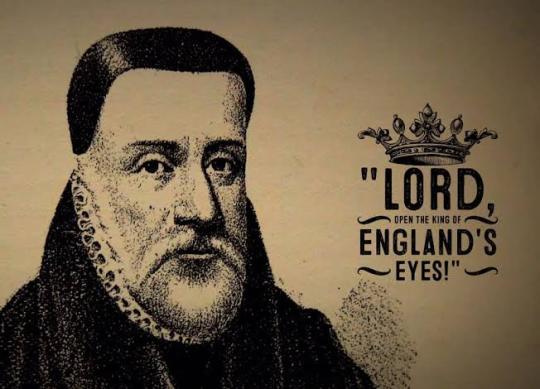
0 notes
Text
Petworth House Collection
Part 2 of our visit to the property - the inside
As I wrote in Part 1, I was sadly underwhelmed by our visit to Petworth, although that doesn’t take away in any part from some of the fabulous works of art and decor which are real treasures.
It’s very difficult times for any kind of ‘attraction’ or museum and I did try to curtail the flat feeling I had with appreciation of being able to go inside the house at all and to see such things. It’s just that I really like to come away from visits with a real sense of who the people were who lived in and shaped the futures of, these historic homes.
One thing I have just discovered is a video they’ve made about the kitchens which, as you read in the last blog, I really wanted to see for myself.
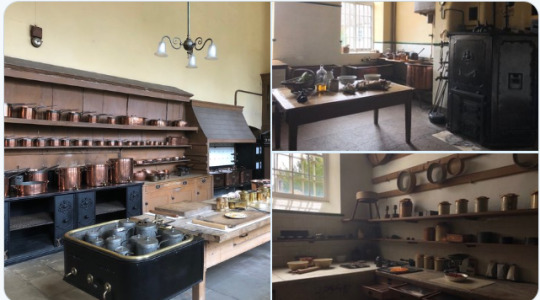
Credit Petworth NT Twitter
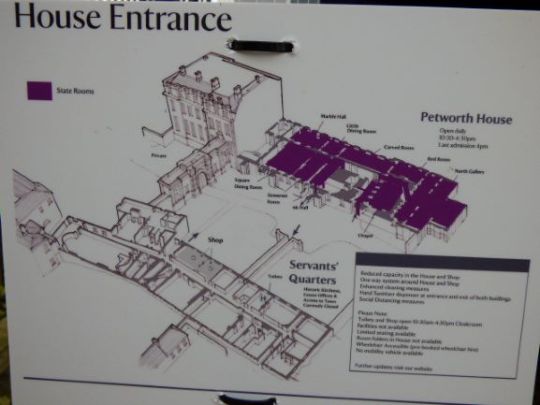
As I said before, only downstairs rooms are open.
Side Note: alterations to the property were carried out in the 1870s by Anthony Salvin, architect, who was also involved in Scotney Castle local to us, which is why the name rang a very loud bell.

The way the house tour is arranged now, you first encounter The Chapel. You’ve got to marvel at anything that dates back to approx 1300.
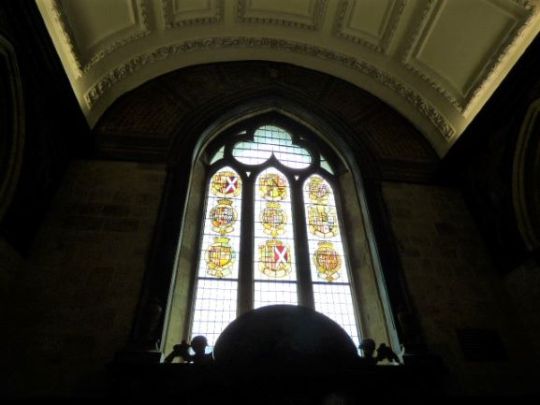
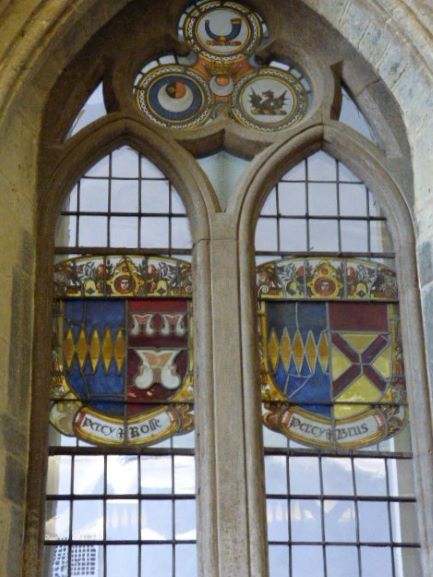
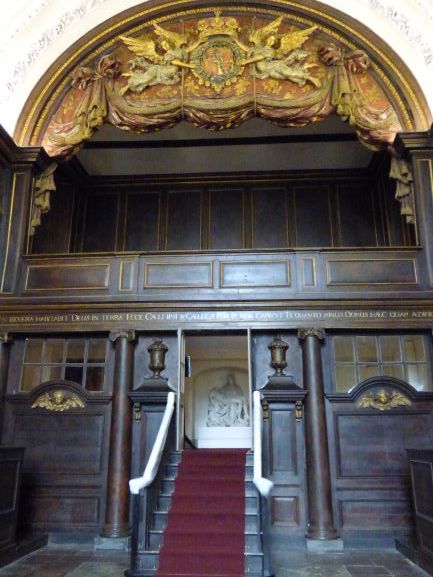
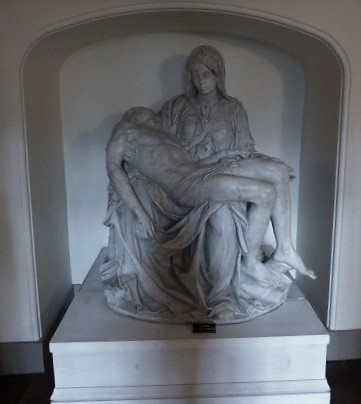
Pietà after Michelangelo Buonarroti
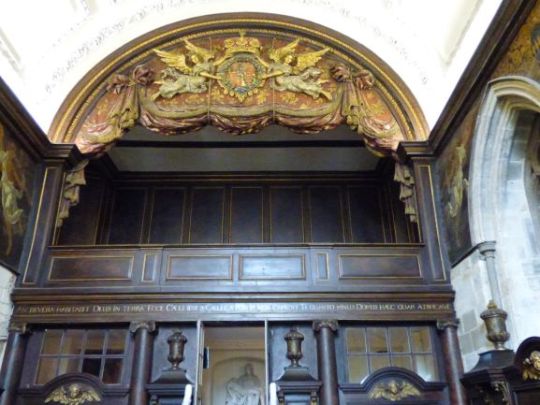
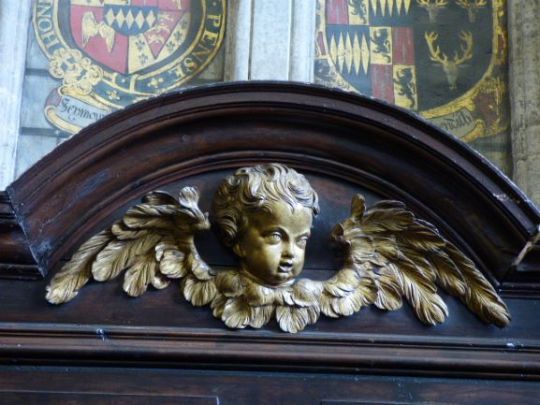
It may just be us. It might be the times, but I didn’t get much of a feeling of peace or of history. The Chapel, despite its ornate decorations seemed dull and dusty and, oh I don’t know, I feel churlish, but it didn’t give me what I expected, or any inspiration. The stained glass is impressive though with all the Percy family commemorations.
I’ve taken a few photos from Trip Advisor which hopefully show things in a different light.
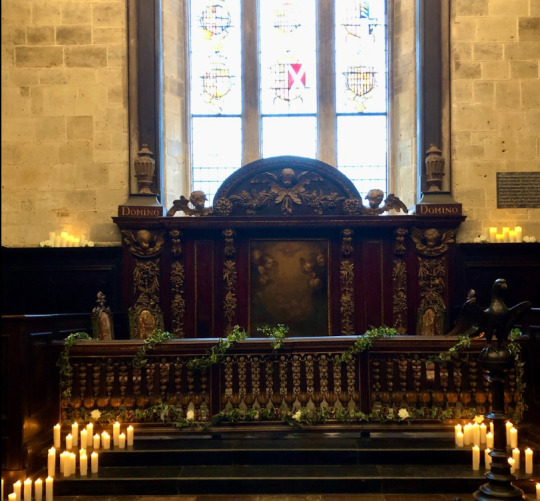
The Chapel at Christmas
Of course, the main attraction at Petworth is the purpose built North Gallery. Here are some of my photos and an indication of what it would usually look like.
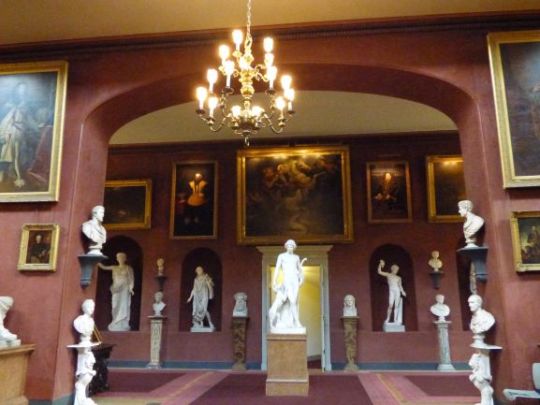
Wander around and take your pick
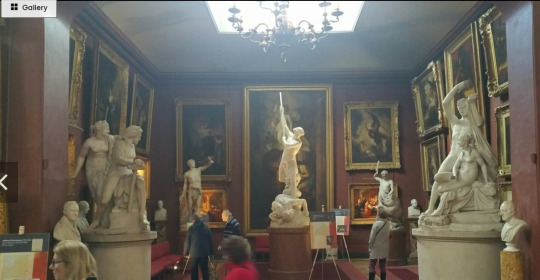
There have previously been sign boards with lots of information
Now, there’s nothing, so it seems more like ‘and here’s another statue’ or ‘here’s another landscape’
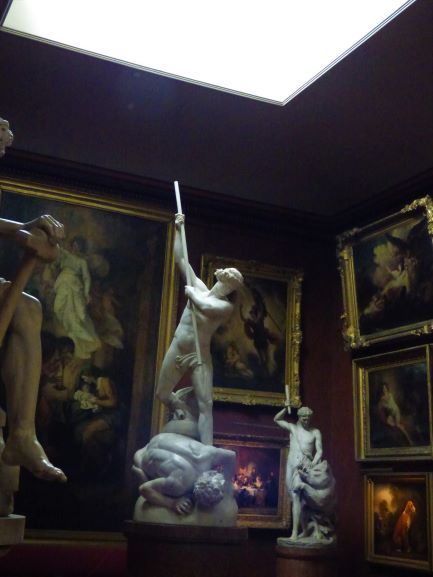
St Michael Slaying Satan John Flaxman RA
Carved from a single piece of marble apart from the spear.
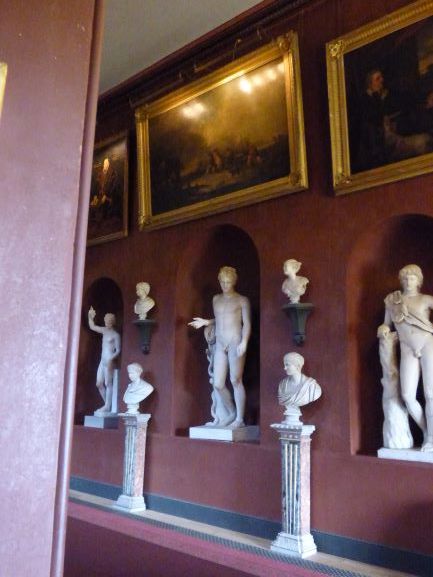
One thing I learned from the guide is demonstrated here by the middle statue, look carefully below.
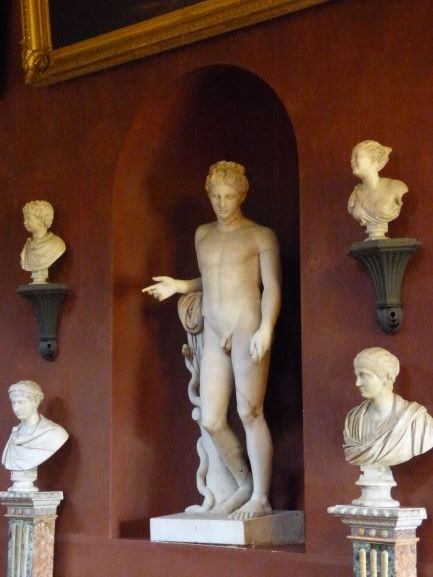
The body of a male with the face of a female - when art works and statues were all but plundered from Continental Europe, the authorities decreed that only damaged and broken statues were permitted to be exported, hence the practice of combining parts to make a whole. I wonder if anyone does a double take?
I can’t really work out why at least some of the information boards can’t be displayed because of Covid procedures. Knowing what you’re looking at makes such a difference.

My favourite piece in the whole house - I’m not exaggerating to say that it blew me away. There’s no sign or information so I’ll put good money on it being overlooked by most visitors.
I enquired and found out that this piece, which is approximately 10x12″ is attributed to Lady Jane Grey
Lady Jane Grey, also known as Lady Jane Dudley (after marriage) and as "the Nine Days' Queen", was an English noblewoman and de facto Queen of England and Ireland from 10 July until 19 July 1553. Jane was the great-granddaughter of Henry VII through his younger daughter Mary, and was a first cousin once removed of Edward VI
History of John Dudley, Duke of Northumberland for anyone who wants to brush up on their history.
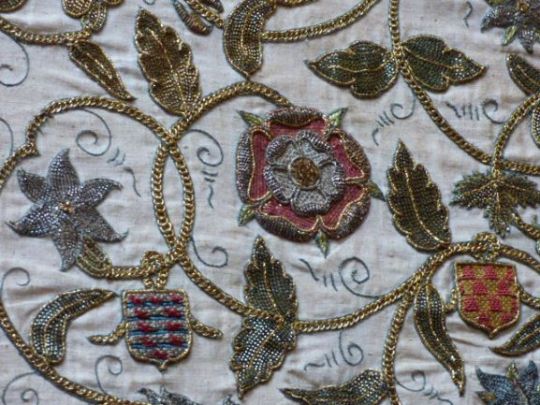
Lady Jane Grey embroidered panel
The colours on this work have held up well considering it must be AT LEAST 467 years old and more likely 470. Lady Jane Grey was only, what? 16 or 17 when she was executed, so this piece of work is reputedly the work of a teenager. It’s so accomplished, so fine, so magnificent that it almost leaves me speechless in awe and these pictures simply can’t do it justice. Frankly, despite my whinging about the visit, this item was worth the journey all by itself. What makes me feel sad about it is that people will walk by and perhaps not even know what it is or why it’s on display.

These are my photographs of the Molyneux Globe, a priceless treasure, which I believe has previously been on display in the North Gallery. Below is a Trip Advisor photo of the information you would usually see.
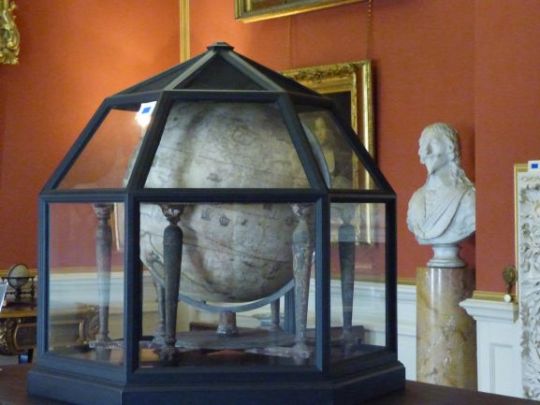
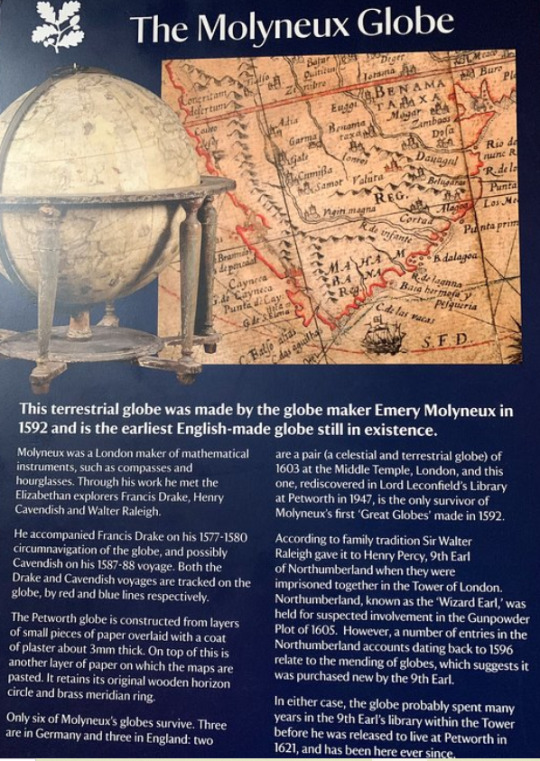
Emery Molyneux (/ˈɛməri ˈmɒlɪnoʊ/ EM-ər-ee MOL-in-oh; died June 1598) was an English Elizabethan maker of globes, mathematical instruments and ordnance. His terrestrial and celestial globes, first published in 1592, were the first to be made in England and the first to be made by an Englishman.
Molyneux was known as a mathematician and maker of mathematical instruments such as compasses and hourglasses. He became acquainted with many prominent men of the day, including the writer Richard Hakluyt and the mathematicians Robert Hues and Edward Wright. He also knew the explorers Thomas Cavendish, Francis Drake, Walter Raleigh and John Davis. Davis probably introduced Molyneux to his own patron, the London merchant William Sanderson, who largely financed the construction of the globes. When completed, the globes were presented to Elizabeth I. Larger globes were acquired by royalty, noblemen and academic institutions, while smaller ones were purchased as practical navigation aids for sailors and students. The globes were the first to be made in such a way that they were unaffected by the humidity at sea, and they came into general use on ships.
Molyneux emigrated to Amsterdam with his wife in 1596 or 1597. He succeeded in interesting the States-General, the parliament of the United Provinces, in a cannon he had invented, but he died suddenly in June 1598, apparently in poverty. The globe-making industry in England died with him.
Only six of his globes are believed still to be in existence. Three are in England, of which one pair consisting of a terrestrial and a celestial globe is owned by Middle Temple and displayed in its library, while a terrestrial globe is at Petworth House in Petworth, West Sussex.
Wikipedia
That’s interesting because I only associated the name Molyneux with the football stadium in Wolverhampton 😊 We live and learn.
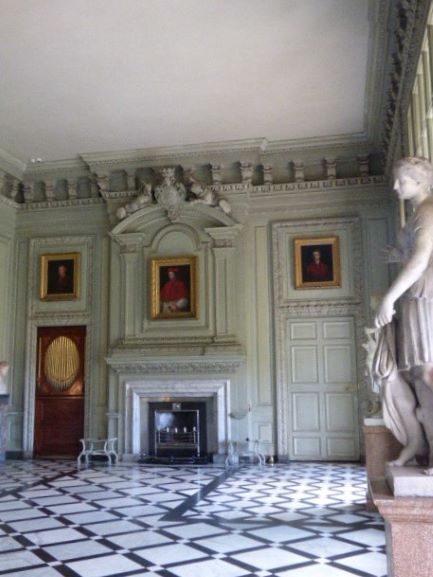
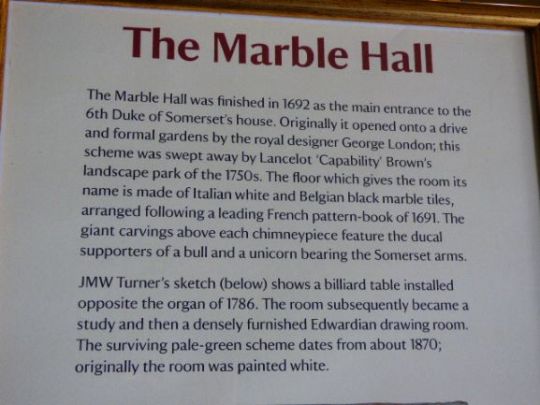
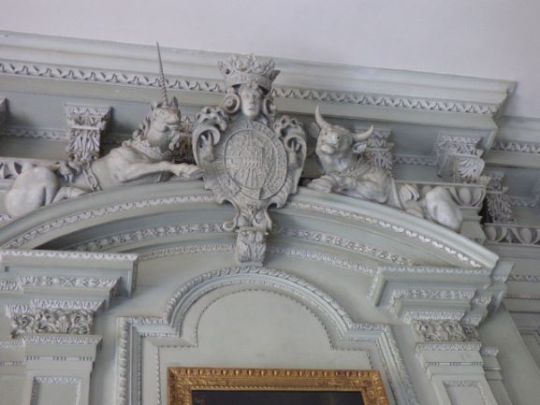
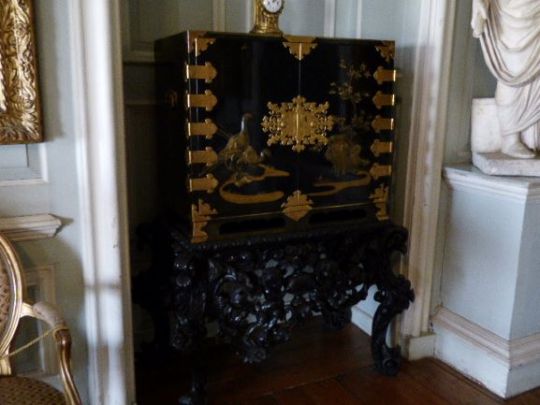
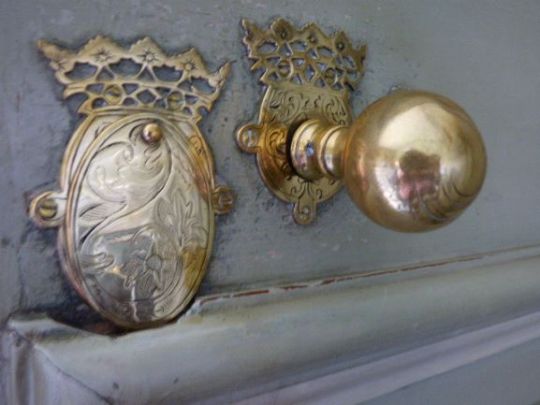
Bespoke locks and door plates - I have a particular interest in these wherever we visit - the craftsmanship and attention to detail is fabulous and I do like a marble floor as well.
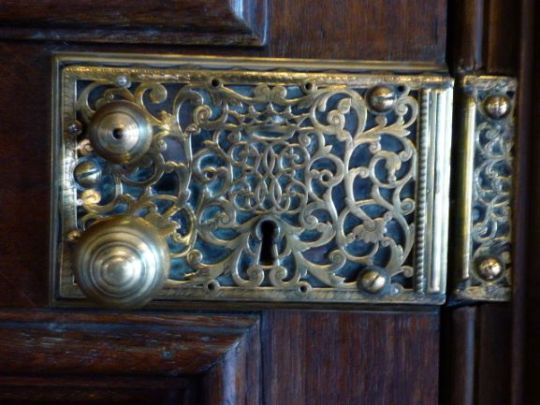
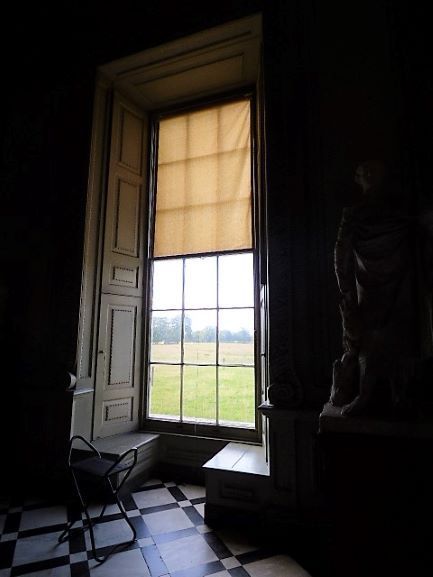
Lovely large windows giving views down to the lake
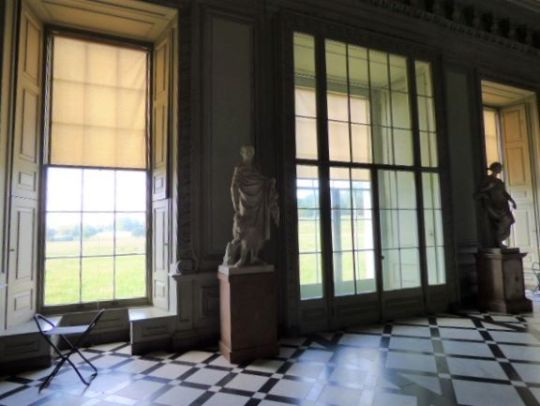
Apparently this was originally an entrance to the house - which is now the back of the house. Personally I’d expected a larger porch area and perhaps some kind of covered outer porch. Get me and my critique.
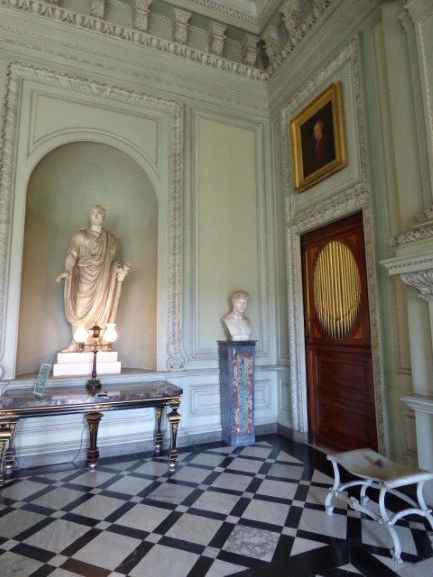
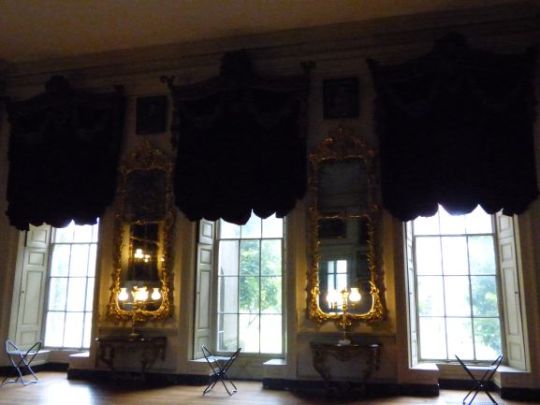
Below is my photograph of the carved hall. It’s not as per the original because two rooms were later knocked through into one with the carvings both modified and also supplemented (from elsewhere in the house and by new additions) Portraits were moved. At a later point in time the base panels were painted over. Every generation makes its own mark I suppose. Having just watched some TV footage of felling ancient woodland in Buckinghamshire to make way for HS2, I have to say, oftentimes things are better off left or preserved.
Read that and weep - in my case, literally.
Points to note are that when the lower level paintings were installed this was so that diners had good viewing from their seated position - clearly that effect is lost on us now and also, the large portraits beyond Henry VIII were originally on the demolished dividing wall and were hung here incorrectly i.e. not complying with the original intention of the artist’s composition of the family.
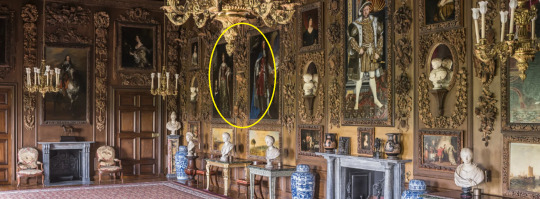
The Duke is pointing to his left which indicates his wife and child portrait should be hung to the viewer’s right side as we look at the scene. Originally they were hung on the (now removed) dividing wall
*Short Video about the Carved Room at Petworth House at the end of the Blog
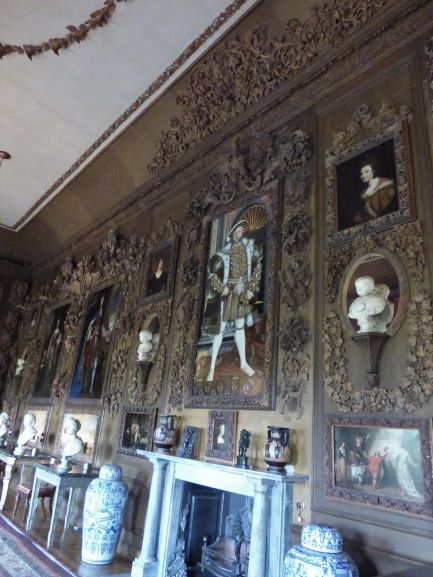
Carved work by Grinling Gibbons
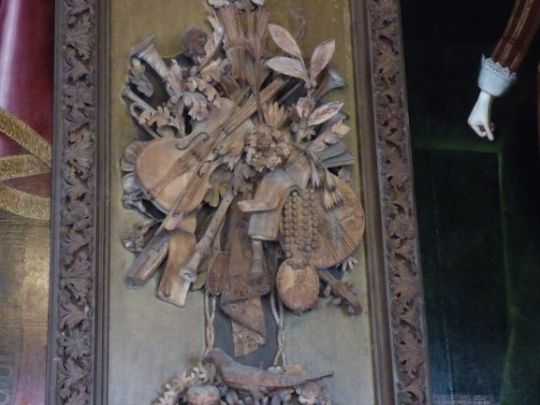
Apparently the carved sheet music is Henry Purcell’s Fairy Queen and can actually be played.
I’ve just discovered a You Tube documentary about Gibbons, which I’ll watch tomorrow. LINK.

So, so many photos. Well, if you’re unlikely to get a chance to visit for yourself, this is a mini tour. I’ve got a separate entry of some artwork snaps.
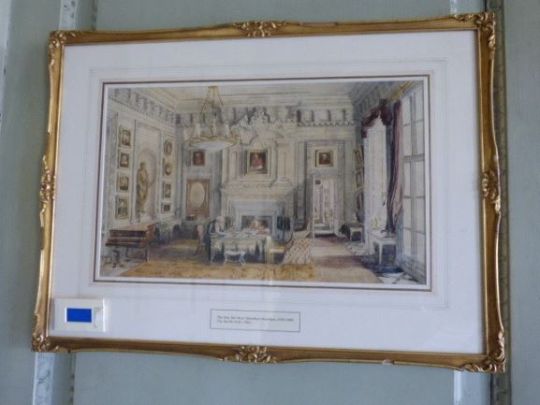
The smaller dining rooms are no longer presented as such but there are some information stands of Turner watercolours from his time at the house. I think other originals are in the Tate Britain collection. Shame as they look charming studies and at the risk of stating the obvious, very at home in this setting. I hadn’t realised how accomplished Turner was or how young he was when he started his studies. His youth was very challenging. A guide recommended the film Mr Turner, which starred Timothy Spall. That’s probably one for the long Winter nights.
*Note the blue monitoring device
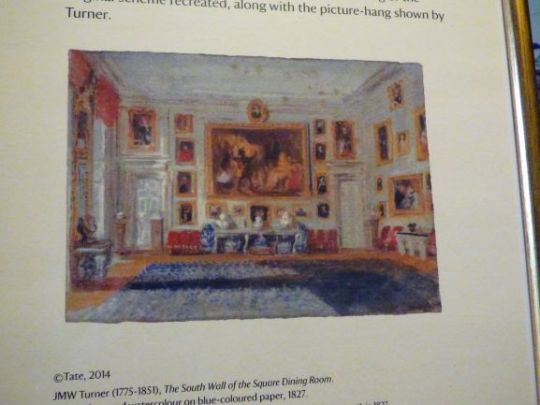
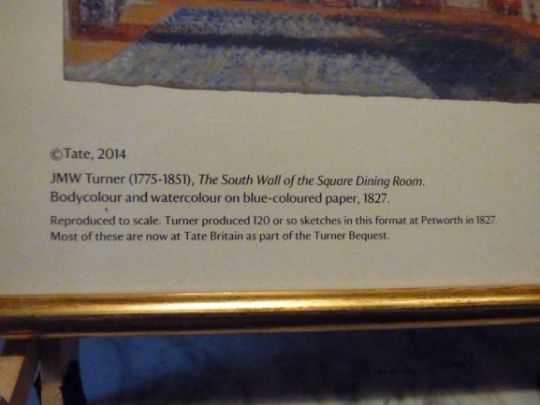

The Square Dining Room dressed for Christmas
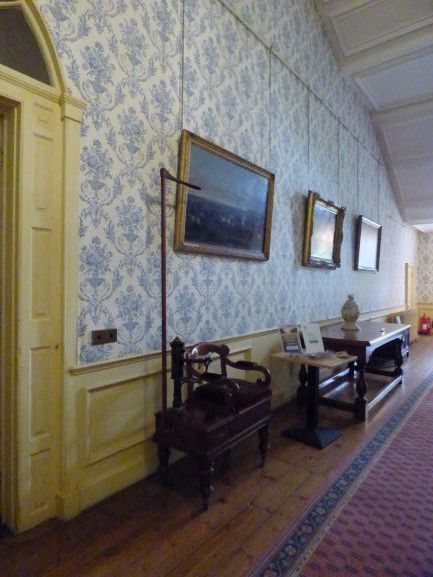
Weighing Scales
check out that link!

Sanitise your hands and exit to the front Courtyard and the Servants’ Quarters opposite.
♦ As always I’m not responsible for the content of outside links, in bold type which are not affiliated to my Blog
0 notes
Text
Enola Holmes Ending Explained: Eudoria, the Reform Act and What’s Next for Enola?
https://ift.tt/2G8pKsV
Warning: contains Enola Holmes plot spoilers
Netflix film Enola Holmes is a revolutionary parable about rejecting the status quo and choosing your own destiny. In it, Stranger Things’ Millie Bobby Brown plays the sixteen-year-old sister of Mycroft and Sherlock Holmes (Sam Claflin and Henry Cavill), a bright spark raised in splendid isolation by their mother Eudoria (Helena Bonham Carter) to think, fight and plot her own path through life. When Eudoria mysteriously disappears, Enola undertakes her first missing persons case and reconnects with her estranged detective brother along the way.
Based on the first in a six-strong series of YA books by Nancy Springer, Enola Holmes is a lively, if overlong, romp with a political heart and a charming central performance by Millie Bobby Brown. With plot spoilers, here’s a breakdown of the major action…
Why did Eudoria Holmes disappear?
Eudoria is a proto-feminist and activist for women’s suffrage (the right to vote). Left alone with a young child after her husband died and sons left home, she devoted the time until Enola was sixteen to equipping her daughter with skills and a liberal education. Then, confident that Enola could fend for herself, Eudoria went undercover as part of the resistance to fight to make the world a fairer place for women.
What was Eudoria planning to do?
First, she extracted money from her son Mycroft (who had inherited Ferndell Hall when his father died) on the pretence that she needed it for upkeep on the property and to maintain a raft of servants and instructors for Enola. Instead, the pair lived with a single housekeeper and Eudoria taught Enola herself, channelling the money to fund her activism.
The explosives Enola discovered in Limehouse Lane were presumably intended to blow up targets in London to protest the lack of women’s suffrage.
What was Edith Grayston’s Tea Shop?
A front for the women’s suffrage organisation to which Eudoria and Edith belong. Edith (played by Susan Wokoma) ran self-defence and Jiu-jitsu classes above the tea shop, an educational facility with “seditious, dangerous and extremely banned bookshelves,” as remarked upon by a visiting Sherlock Holmes.
Who was trying to kill the Viscount Tewksbury and why?
His grandmother, the Dowager, played by Frances de la Tour (perhaps best recognised by young audiences for the role of half-giant Madame Maxime in Harry Potter and the Goblet of Fire). Enola was right – a widow is a very handy disguise. A staunch conservative who opposed reformation in any form, the Dowager felt it was her duty as a member of the British landed gentry to preserve the family estate – and England – exactly as it was, and to stand in the way of progress. She explained as much to Enola on their walk through Bellwether House grounds.
The Dowager knew that her eldest son – the young Viscount’s father – was a radical who would use his vote in the House of Lords (the UK parliament’s second chamber, at that time filled solely by hereditary peers who inherited their titles, seats and power without appointment or election, with the power to scrutinise bills approved by the elected members of the House of Commons) to pass reform acts, therefore changing the status quo. She staged a burglary in which her son was killed, and then, when his similarly progressive son came of age and inherited the peerage, she employed an assassin to attempt to kill him too.
When the Viscount and Enola defeated the assassin, the Dowager shot her own grandson in the chest, telling him “I’m so sorry my darling. The future of the country is at stake.” He survived thanks to a hastily inserted chest plate from a nearby suit of armour during the attack, telling his reactionary grandmother “Your time is over.”
Read more
Movies
Enola Holmes Review: Millie Bobby Brown’s Revolution Lacks Revelation
By Natalie Zutter
Movies
Sherlock Holmes History Proves Enola Holmes Lawsuit is Nonsense
By Ryan Britt
What was the Reform Act passed in 1884?
“Reform, god help us, if it’s one thing this country doesn’t need, it’s more uneducated voters. England is going to pot.” – Mycroft Holmes
The Third Reform Act, or officially, the Representation of the People Act 1884, was introduced by Liberal prime minister William Gladstone. In simple terms, it gave the vote to many more British citizens outside of the wealthy gentry, and marked a shift towards a more democratically elected House of Commons.
Initially the House of Lords rejected the Third Reform Act, which gave Gladstone a battle and led to popular protest, but it was eventually passed in the Lords.
Previously, the power to vote in elections was only held by wealthy landowners in boroughs, not rural counties. The Third Reform Act extended the franchise (the number of people eligible to vote) to middle class landowners and working class agricultural workers paying an annual rent of £10. In combination with the Redistribution Act passed in 1885, which matched the number of members of parliament for an area to its population, making it more equitable, the Act made for a fairer and more democratic United Kingdom… for some. It did not grant the vote for women or 40% of men in the UK, who were non-landowning and non-propertied.
Who left Enola the code in the newspaper personal ad?
Sherlock, who deliberately included a hint that the message was from him and not their mother, as it purported to be, as a test for Enola’s deductive powers. When Enola passed the test (after also having solved the mystery of the missing Marquess before him), Sherlock asked to take responsibility as her legal guardian, which Mycroft gratefully granted.
What was the significance of ‘Dash’ the pinecone?
The wool-wrapped pinecone was Enola’s childhood toy, inspired by Queen Victoria’s spaniel of the same name. Enola had forgotten all about it, but her mother kept it underneath her pillow as a symbol of her affection for her daughter. Sherlock retrieved it and returned it to Enola as proof of their mother’s love, then Enola left it at the Royal Academy for Sherlock to find as a sign that she had cracked the code he’d left for her in the newspaper personal ad.
What next for Enola?
“I am a detective, I am a decipherer and I am a finder of lost souls. My life is my own and the future is up to us.”
Enola was left living in her own (much more salubrious) London lodgings, having earned a hefty reward from the doting mother of the Missing Marquess. She was no longer a ward of Mycroft, who’d wanted her enrolled at a suffocating finishing school, but the legal responsibility of Sherlock Holmes – in this incarnation of his character, her much more sympathetic and supportive brother. She was also in the early stages of a romance with Lord Tewksbury, and beginning life as a detective in her own right. Her mother Eudoria remained underground as part of the feminist resistance.
Will there be an Enola Holmes 2 sequel?
Author Nancy Springer published six Enola Holmes mysteries between 2006-2010, starting with this story, The Case of the Missing Marquess. That means, if Netflix, Millie Bobby Brown and the fans are up for it, there are several possible opportunities for a sequel adaptation. The next book in the series is titled The Case of the Left-Handed Lady and involves the disappearance of the aristocratic Lady Cecily Alistair…
cnx.cmd.push(function() { cnx({ playerId: "106e33c0-3911-473c-b599-b1426db57530", }).render("0270c398a82f44f49c23c16122516796"); });
Enola Holmes is available to stream on Netflix now.
The post Enola Holmes Ending Explained: Eudoria, the Reform Act and What’s Next for Enola? appeared first on Den of Geek.
from Den of Geek https://ift.tt/3j8qvko
0 notes
Photo
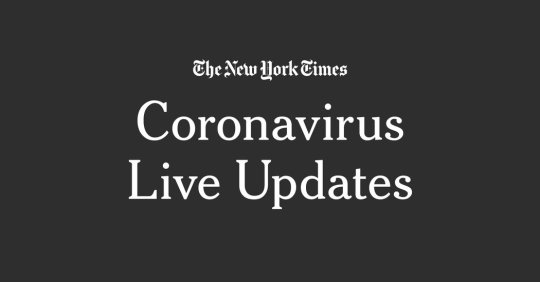
New Post has been published on https://techcrunchapp.com/covid-19-news-live-updates-the-new-york-times-10/
Covid-19 News: Live Updates - The New York Times

Trump supporters gather indoors as journalists ask why he played down the virus.
President Trump on Sunday held a campaign rally indoors for the first time since late June, when he appeared at an event in Tulsa, Okla., that was later blamed for a surge in coronavirus cases in the area.
The rally on Sunday night, held at a manufacturing plant outside Las Vegas in defiance of a state directive limiting indoor gatherings to 50 people, was attended by thousands of supporters, the vast majority of whom did not wear masks.
Steve Sisolak, the Democratic governor of Nevada, said on Twitter that Mr. Trump was “taking reckless and selfish actions” that endangered the lives of people in the state. “This is an insult to every Nevadan who has followed the directives, made sacrifices and put their neighbors before themselves,” he said. “It’s also a direct threat to all of the recent progress we’ve made, and could potentially set us back.”
The Trump campaign had vetted several outdoor venues, but they were all blocked by the governor, according to an administration official familiar with the planning. Tim Murtaugh, a campaign spokesman, defended the indoor setting, saying in a statement, “If you can join tens of thousands of people protesting in the streets, gamble in a casino, or burn down small businesses in riots, you can gather peacefully under the First Amendment to hear from the president of the United States.”
Earlier in the day, White House and Republican officials struggled to respond to sharp questioning by Sunday morning news hosts about why Mr. Trump knowingly played down the coronavirus in the crucial early months of the pandemic, as revealed by the journalist Bob Woodward in his new book, “Rage.”
The White House trade adviser, Peter Navarro, claimed on the CNN program “State of the Union” that “nobody knew” how dangerous the virus was at the time the president spoke to Mr. Woodward in February and March. In fact, Mr. Navarro himself wrote a memo in late January warning Trump administration officials that the virus could cost the United States trillions of dollars and put millions of Americans at risk of illness or death.
Ronna McDaniel, the chairwoman of the Republican National Committee, provided a different defense of the president, saying that Mr. Trump had understood the serious threat the virus posed by early February but was “calm and steady and methodical” because he did not want to cause a panic.
Dr. Scott Gottlieb, the former commissioner of the Food and Drug Administration under Mr. Trump, suggested on the CBS program “Face the Nation” that the president might have chosen to underplay the seriousness of the virus in part because he was getting bad information early on from the Centers for Disease Control and Prevention and other health agencies.
In an interview with “60 Minutes” that aired on Sunday night, Mr. Woodward discussed interviews he recorded with the president. He said Mr. Trump was warned about the danger at a Jan. 28 meeting by a deputy national security adviser, Matthew Pottinger.
“Pottinger said his contacts in China told him, ‘This is going to be like the 1918 Spanish flu pandemic that killed 675,000 people in this country,’” Mr. Woodward said.
Amazon said on Monday that it would hire 100,000 new workers in the United States and Canada for its warehouses and logistics network, another sign that the pandemic has resulted in a huge growth in demand for the e-commerce giant.
Amazon has been one of the biggest winners of the crisis as people turn to online shopping rather than visit traditional brick-and-mortar retailers; those businesses have been decimated. As the broader economy suffered from the economic fallout of Covid-19, Amazon reported record sales and profit last quarter.
Dave Clark, senior vice president of worldwide operations for Amazon, said in a news release that the company was opening 100 buildings this month for sorting products, delivery and other purposes. The new jobs will pay a starting wage of $15 per hour and will include a $1,000 starting bonus in some cities.
The hiring announcement is on top of the 33,000 salaried job openings that Amazon said last week it had available in areas such as cloud computing and warehouse management. In 2020, Amazon said, it has opened 75 new fulfillment and sorting centers, regional air hubs and delivery stations in the United States and Canada.
Amazon previously said that it hired 175,000 additional people to meet the huge surge in demand related to Covid-19.
Silvio Berlusconi, the former Italian prime minister, left the San Raffaele Hospital in Milan on Monday morning. It had been nearly two weeks since he was admitted with pneumonia after contracting the coronavirus.
“It was a difficult ordeal,” Mr. Berlusconi said, “perhaps the most dangerous of my life.” He warned Italians not to underestimate the gravity of the virus and to act responsibly.
Mr. Berlusconi left the hospital shortly before noon to a smattering of applause and a gaggle of reporters. In a short, prepared speech, the 83-year old media mogul turned politician described the first three days of his stay as especially difficult. Doctors later told him, he said, that his viral count was the highest ever registered at the Milanese hospital.
Coronavirus cases have been growing in Italy in recent weeks, and Mr. Berlusconi most likely contracted the virus while vacationing on the island of Sardinia, which became a viral hot spot in August.
Mr. Berlusconi said Monday that his thoughts were with those who had “this very dangerous” virus and their families, as well as with doctors and health workers who had been working to assist them. “Many have lost their lives, and they have all been exposed to the virus in doing their duty,” he said.
Italian students returned to school on Monday, and Mr. Berlusconi urged them to “not underestimate” the virus and to be rigorous in respecting social-distancing rules.
It was Europe’s largest refugee camp. Its squalid conditions made it one of the most notorious. Then the coronavirus found its way in.
If the Moria refugee camp on the Greek island of Lesbos was a tinderbox, the virus was the spark.
When the authorities tried to quarantine the residents, a small group of asylum seekers, angry that their living situations were somehow about to get even worse, began setting blazes, officials and aid workers say.
Now, with the camp destroyed, some 8,000 adults and 4,000 children, among them hundreds of infants, are stranded without shelter or sanitation.
“We escaped from fire, but everything is black,” said Mujtaba Saber, sitting on a thin blanket spread on a street, next to his napping 3-year-old son. His 20-day-old baby slept nearby in her mother’s arms.
The Times’s Matina Stevis-Gridneff, who is on Lesbos, reports that the Greek army has been setting up a new camp. The authorities said they hoped to relocate the migrants, nearly two-thirds of whom are Afghans, into 2,000 tents.
For now, they’ve been sleeping on tombstones and the side of the road, in parking lots and dried weeds on the hillsides. Some have pitched makeshift tents with bamboo poles and blankets. They’ve used the few clothes they have to make mattresses so their babies don’t sleep on tarmac.
“I think sleeping on the street is bad, but Moria is bad-bad,” said Mahbube Ahzani, 15, who had been in the camp with her family for 10 months. But what will be worse, she said, is the “new Moria.”
In other developments around the world:
New Zealand is likely to end coronavirus restrictions on Sept. 21, with the exception of its largest city, Auckland, where an outbreak occurred last month. Prime Minister Jacinda Ardern said on Monday that current alert levels would be maintained for another week and then be lowered if case numbers stayed the same. She also said physical distancing rules on planes and other public transportation would be dropped, allowing more passengers to travel at the same time, though they still must wear masks. New Zealand reported one new case on Monday linked to the Auckland cluster, bringing the country’s total to 1,798.
India reported 92,071 new cases on Monday, the fifth consecutive day that new cases exceeded 90,000 in the country, according to a New York Times database. India has the world’s second-highest number of cases after the United States. On Monday, members of Parliament were gathering for a session with social-distancing precautions.
Starting Monday, Britain has lowered the limit on the number of people allowed to meet to six from 30. The country recorded 3,330 new infections on Sunday, the third consecutive day of new case counts surpassing 3,000, a level not seen in Britain since May.
Also in Britain, London’s West End will reopen its first musical since March. “Six,” the hit about the wives of King Henry VIII, will start an 11-week run at the Lyric Theater on Nov. 14. It was supposed to debut on Broadway the day New York’s theaters closed.
Antarctica, the only continent free of the coronavirus, is preparing for an influx of researchers in the coming months as a change of season makes studies on the icy South Pole more feasible. The first researchers, from the United States, arrived on Monday after quarantining in New Zealand.
Israel will be returning to a nationwide lockdown for at least three weeks, starting on Friday, the eve of the Jewish New Year.
A health official in Australia said on Monday that she was under police protection because of death threats amid rising opposition to her pandemic policies. Dr. Jeannette Young, the chief health officer of Queensland, had been criticized over a requirement that travelers from other parts of Australia quarantine for two weeks, especially after a woman in quarantine was not allowed to attend her father’s funeral.
Ethiopia, which has some of the highest virus cases and deaths in Africa, formed a partnership with a Chinese company to increase testing capacity. On Sunday, Prime Minister Abiy Ahmed presided over the opening of a commercial test-kit production facility in the capital that he said would produce kits for both the local market and export, with a focus on African nations.
The outcry was galvanized by the news that AstraZeneca’s chief executive disclosed why it had recently halted its vaccine trial — because a person given the vaccine had experienced serious neurological symptoms — at a closed meeting organized by J.P. Morgan, the investment bank.
AstraZeneca said on Saturday that an outside panel had cleared its trial in Britain to begin again, but the company has not given any details about the patient’s condition, nor has it released a transcript of the executive’s remarks to investors, which were reported by the news outlet STAT and later confirmed by an analyst for J.P. Morgan.
Another front-runner in the vaccine race, Pfizer, made a similarly terse announcement on Saturday: The company is proposing to expand its clinical trial to include thousands more participants, but it gave few other details.
Critics say American taxpayers are entitled to know more since the federal government has committed billions of dollars to vaccine research and to buying the vaccines. And greater transparency could also help bolster faltering public confidence in vaccines.
“Trust is in short supply,” said Dr. Harlan Krumholz, a cardiologist and health care researcher at Yale University in New Haven, Conn., who has spent years prodding companies and academic researchers to share more trial data with outside scientists. “And the more that they can share, the better off we are.”
The National Football League’s season got into full swing on Sunday, and Kurt Streeter, a sports columnist for The Times, was watching. He writes:
The return of professional football to a nation living on a raw and perilous edge, still struggling to confront a lethal virus and trying to heal its deep racial wounds, offered fans a tense and unlikely paradox. I loved watching the games, but I loathed it, too.
After so many endless, pent-up weeks, maybe you couldn’t wait to see the impossible tackles and stunning touchdowns. But at the same time, maybe you worried about what the return of professional football might mean for sports, for the nation and for all of us.
Hold tight. We could be one big outbreak of Covid-19 away from a calamity and deep regret.
Reporting was contributed by Livia Albeck-Ripka, Abdi Latif Dahir, Jennifer Jett, Annie Karni, Isabel Kershner, Alex Marshall, Jennifer Medina, Elisabetta Povoledo, Adam Satariano, Anna Schaverien, Matina Stevis-Gridneff, Kurt Streeter, and Katie Thomas.
0 notes
Photo

Today in history, June 16, 1487: the Battle of Stoke Field:
"The Battle of Stoke Field on 16 June 1487 may be considered the last battle of the Wars of the Roses, since it was the last major engagement between contenders for the throne whose claims derived from descent from the houses of Lancaster and York respectively. The Battle of Bosworth Field, two years previously, had established King Henry VII on the throne, ending the last period of Yorkist rule and initiating that of the Tudors. The Battle of Stoke Field was the decisive engagement in an attempt by leading Yorkists to unseat him in favour of the pretender Lambert Simnel.
Though it is often portrayed as almost a footnote to the major battles between York and Lancaster, it may have been slightly larger than Bosworth, with much heavier casualties, possibly because of the terrain which forced the two sides into close, attritional combat. In the end, though, Henry's victory was crushing. Almost all the leading Yorkists were killed in the battle.
Henry VII of England held the throne for the House of Lancaster (House of Tudor), and had tried to gain the acceptance of the Yorkist faction by his marriage to their heiress, Elizabeth of York, but his hold on power was not entirely secure.
The chief claimant of the York dynasty was the queen's first cousin, Edward, Earl of Warwick, the son of George, Duke of Clarence. This boy was kept confined in the Tower of London.
An impostor claiming to be Edward, whose name was Lambert Simnel, came to the attention of John de la Pole, Earl of Lincoln through the agency of a priest called Richard Symonds. Lincoln, although apparently reconciled with the Tudor king, himself had a claim on the throne; moreover, the last Plantagenet, Richard III of England, had named Lincoln, his nephew, as the royal heir. Although he probably had no doubt about Simnel's true identity, Lincoln saw an opportunity for revenge and reparation
Lincoln fled the English court on 19 March 1487 and went to the court of Mechelen (Malines) and his aunt, Margaret, Duchess of Burgundy. Margaret provided financial and military support in the form of 2000 German and Swiss mercenaries, under the commander Martin Schwartz. Lincoln was joined by a number of rebel English Lords at Mechelen, in particular Richard III's loyal supporter, Lord Lovell, Sir Richard Harleston, the former governor of Jersey and Thomas David, a captain of the English garrison at Calais. The Yorkists decided to sail to Ireland, where the Yorkist cause was popular, to gather more supporters.
The Yorkist fleet set sail and arrived in Dublin on 4 May 1487. With the help of Gerald FitzGerald, 8th Earl of Kildare and his brother Thomas FitzGerald of Laccagh, Lord Chancellor of Ireland, Lincoln recruited 4,500 Irish mercenaries, mostly kerns, lightly armoured but highly mobile infantry.
With the support of the Irish nobility and clergy, Lincoln had the pretender Lambert Simnel crowned "King Edward VI" in Dublin on 24 May 1487. Although a Parliament was called for the new "King", Lincoln had no intention of remaining in Dublin and instead packed up the army and Simnel and set sail for north Lancashire.
On landing on 4 June 1487, Lincoln was joined by a number of the local gentry led by Sir Thomas Broughton. In a series of forced marches, the Yorkist army, now numbering some 8,000 men, covered over 200 miles in five days. On the night of 10 June, at Bramham moor, outside Tadcaster, Lovell led 2,000 men on a night attack against 400 Lancastrians, led by Lord Clifford. The result was an overwhelming Yorkist victory.
Lincoln then outmanoeuvered King Henry's northern army, under the command of the Earl of Northumberland by ordering a force under John, Lord Scrope to mount a diversionary attack on Bootham Bar, York, on 12 June. Lord Scrope then withdrew northwards, taking Northumberland's army with him.
Lincoln and the main army continued southwards. Outside Doncaster, Lincoln encountered Lancastrian cavalry under Edward Woodville, Lord Scales. There followed three days of skirmishing through Sherwood Forest. Lincoln forced Scales back to Nottingham, where Scales' cavalry stayed to wait for the main royal army. However, the fighting had slowed down the Yorkist advance sufficiently to allow King Henry to receive substantial reinforcements under the command of Lord Strange by the time he joined Scales at Nottingham on 14 June. Rhys ap Thomas, Henry's leading supporter in Wales, also arrived with reinforcements.
Henry's army now outnumbered the Yorkists. In addition, it was "far better armed and equipped" than the Yorkist army. His two principal military commanders, Jasper Tudor and John de Vere, 13th Earl of Oxford, were also more experienced than the Yorkist leaders.
On 15 June, King Henry began moving north east toward Newark after receiving news that Lincoln had crossed the River Trent. Around nine in the morning of 16 June, King Henry's forward troops, commanded by the Earl of Oxford, encountered the Yorkist army assembled in a single block, on a brow of Rampire Hill surrounded on three sides by the River Trent at the village of East Stoke. Their right flank was anchored on a high spot known as Burham Furlong.
Henry's army was divided into three battles, of which Oxford led the vanguard. As at Bosworth, the king left the direction of the fighting itself to Oxford. Before the fight began some unusual lights in the sky were interpreted as ill-portents by Lancastrian soldiers, leading to some desertions, but Oxford and other nobles were able to restore morale, and soon the army was in "good array and in a fair battle".
The Yorkists, arrayed in a single concentrated formation, were assaulted by arrows. Suffering from the arrows, they chose to surrender the high ground by immediately going on to the attack in the hope of breaking the Lancastrian line and rolling up the enemy army. Though outnumbered overall, the Yorkists had the advantage of a "core of well-trained foreign mercenaries", and their concentrated force outnumbered Oxford's vanguard, which was the only part of the Lancastrian army engaged.
The vanguard was badly shaken, but Oxford was able to rally his force. The battle was bitterly contested for over three hours, but eventually, sheer attrition told against the Yorkists after they failed to break the Lancastrian position early on. Henry chose not to commit his other "battles", leaving the struggle to the vanguard, which was probably repeatedly reinforced as Lancastrian contingents came up, directed by Jasper Tudor. Though the German mercenaries were equipped with the latest handguns, the presence of large numbers of traditional archers in the Lancastrian army proved decisive. The skilled longbowmen were able to shoot volley after volley into the Yorkist position. The lack of body armour on the Irish troops in particular meant that they were cut down in increasing numbers by repeated showers of arrows.
Unable to retreat (with the river on three sides), the German and Swiss mercenaries fought it out. According to Jean Molinet, by the end of the battle they were "filled with arrows like hedgehogs". The broken Yorkists fled towards the Trent down a ravine (known locally even today as the Bloody Gutter) in which many were cornered and killed. All of the Yorkist commanders—Lincoln, Fitzgerald, Broughton, and Schwartz—fell fighting. Only Lord Lovell may have escaped. He disappeared after the battle and was never seen again. He may have gone to Scotland, as there is evidence of a safe conduct pass being granted him there, but his later fate is unknown. In the 18th century a body was found inside a secret room at his house in Minster Lovell, Oxfordshire, leading to conjecture that it was his.
Simnel was captured, but was pardoned by Henry in a gesture of clemency which did his reputation no harm. Henry realised that Simnel was merely a puppet for the leading Yorkists. He was given a job in the royal kitchen, and later promoted to falconer. The Irish nobles who had supported Simnel were also pardoned, as Henry believed he needed their support to govern Ireland effectively. However, Henry later persuaded the Pope to excommunicate the Irish clergy who had supported the rebellion. Two other Yorkist conspirators were also captured: Richard Symonds and John Payne, Bishop of Meath. Symonds was the man who had introduced Lincoln to Simnel; Payne had preached the sermon at Simnel's coronation. Neither was executed: Symonds was imprisoned, and Payne was pardoned and eventually restored to royal favour.
To mark his victory, Henry raised his standard on Burham Furlong. The spot is marked by a large stone memorial with the legend "Here stood the Burrand Bush planted on the spot where Henry VII placed his standard after the Battle of Stoke 16 June 1487". Henry knighted many of his supporters in the aftermath of the battle. A handwritten list of the new knights by John Writhe survives inserted into a copy of the book Game and Play of Chess. Thirteen new bannerets were created and fifty two men were knighted.
Henry had hoped to capture Lincoln alive in order to learn from him the true extent of support for the Yorkists. Instead Henry launched a series of enquiries, the outcome of which was "relatively few executions and very many fines", consistent with Henry's policy of controlling the aristocracy by weakening it financially. After the battle, he progressed north through Pontefract, York, Durham and Newcastle to show himself in those areas that had been strongholds of Richard III's supporters.
Later in Henry's reign another pretender to the throne emerged, in the person of Perkin Warbeck; however, this time the matter was resolved without having to fight a major battle."
23 notes
·
View notes
Text
Events 10.22
362 – The temple of Apollo at Daphne, outside Antioch, is destroyed in a mysterious fire. 451 – The Council of Chalcedon adopts the Chalcedonian Creed regarding the divine and human nature of Jesus Christ. 794 – Emperor Kanmu relocates the Japanese capital to Heian-kyō (now Kyoto). 906 – Ahmad ibn Kayghalagh leads a raid against the Byzantine Empire from Tarsus. He reaches the Halys River and takes 4,000–5,000 captives.[1] 1383 – The 1383–85 Crisis in Portugal: King Fernando dies without a male heir to the Portuguese throne, sparking a period of civil war and disorder. 1575 – Foundation of Aguascalientes. 1633 – Battle of Liaoluo Bay: The Ming dynasty defeats the Dutch East India Company. 1707 – Scilly naval disaster: Four British naval vessels run aground on the Isles of Scilly because of faulty navigation. In response, the first Longitude Act is enacted in 1714. 1730 – Construction of the Ladoga Canal is completed. 1746 – The College of New Jersey (later renamed Princeton University) receives its charter. 1777 – American Revolutionary War: American defenders of Fort Mercer on the Delaware River repulse repeated Hessian attacks in the Battle of Red Bank. 1784 – Russia founds a colony on Kodiak Island, Alaska. 1790 – Warriors of the Miami people under Chief Little Turtle defeat United States troops under General Josiah Harmar at the site of present-day Fort Wayne, Indiana, in the Northwest Indian War. 1797 – André-Jacques Garnerin makes the first recorded parachute jump from one thousand meters (3,200 feet) above Paris. 1836 – Sam Houston is inaugurated as the first President of the Republic of Texas. 1844 – The Great Anticipation: Millerites, followers of William Miller, anticipate the end of the world in conjunction with the Second Advent of Christ. The following day became known as the Great Disappointment. 1859 – Spain declares war on Morocco. 1866 – A plebiscite ratifies the annexion of Veneto and Mantua to Italy, which had occurred three days before, on October 19. 1875 – First telegraphic connection in Argentina. 1877 – The Blantyre mining disaster in Scotland kills 207 miners. 1878 – The first rugby match under floodlights takes place in Salford, between Broughton and Swinton. 1879 – Using a filament of carbonized thread, Thomas Edison tests the first practical electric incandescent light bulb (it lasted 13½ hours before burning out). 1883 – The Metropolitan Opera House in New York City opens with a performance of Gounod's Faust. 1884 – The Royal Observatory in Britain is adopted as the prime meridian of longitude by the International Meridian Conference. 1895 – In Paris an express train derails after overrunning the buffer stop, crossing almost 30 metres (100 ft) of concourse before crashing through a wall and falling 10 metres (33 ft) to the road below. 1907 – Panic of 1907: A run on the stock of the Knickerbocker Trust Company sets events in motion that will lead to a depression. 1910 – Dr. Crippen is convicted at the Old Bailey of poisoning his wife and is subsequently hanged at Pentonville Prison in London. 1923 – The royalist Leonardopoulos–Gargalidis coup d'état attempt fails in Greece, discrediting the monarchy and paving the way for the establishment of the Second Hellenic Republic. 1927 – Nikola Tesla introduces six new inventions including single-phase electric power. 1928 – Phi Sigma Alpha fraternity is founded at the University of Puerto Rico, Río Piedras Campus. 1934 – In East Liverpool, Ohio, Federal Bureau of Investigation agents shoot and kill notorious bank robber Pretty Boy Floyd. 1941 – World War II: French resistance member Guy Môquet and 29 other hostages are executed by the Germans in retaliation for the death of a German officer. 1943 – World War II: in the Second firestorm raid on Germany, the Royal Air Force conducts an air raid on the town of Kassel, killing 10,000 and rendering 150,000 homeless. 1946 – Soviet Operation Osoaviakhim takes place, recruiting of thousands of military-related technical specialists from the Soviet occupation zone of post–World War II Germany for employment in the Soviet Union. 1947 – Kashmir conflict starts, a territorial conflict primarily between India and Pakistan, having started just after the partition of India in 1947. 1957 – Vietnam War: First United States casualties in Vietnam. 1962 – Cuban Missile Crisis: US President John F. Kennedy, after internal counsel from Dwight D. Eisenhower, announces that American reconnaissance planes have discovered Soviet nuclear weapons in Cuba, and that he has ordered a naval "quarantine" of the Communist nation. 1963 – A BAC One-Eleven prototype airliner crashes in UK with the loss of all on board. 1964 – Jean-Paul Sartre is awarded the Nobel Prize in Literature, but turns down the honor. 1964 – Canada: A Multi-Party Parliamentary Committee selects the design which becomes the new official flag of Canada. 1966 – The Supremes become the first all-female music group to attain a No. 1 selling album (The Supremes A' Go-Go). 1966 – The Soviet Union launches Luna 12. 1968 – Apollo program: Apollo 7 safely splashes down in the Atlantic Ocean after orbiting the Earth 163 times. 1972 – Vietnam War: In Saigon, Henry Kissinger and South Vietnamese President Nguyễn Văn Thiệu meet to discuss a proposed cease-fire that had been worked out between Americans and North Vietnamese in Paris. 1975 – The Soviet unmanned space mission Venera 9 lands on Venus. 1976 – Red Dye No. 4 is banned by the US Food and Drug Administration after it is discovered that it causes tumors in the bladders of dogs. 1978 – Papal inauguration of Pope John Paul II. 1981 – The United States Federal Labor Relations Authority votes to decertify the Professional Air Traffic Controllers Organization (PATCO) for its strike the previous August. 1981 – The founding congress of the Nepal Workers and Peasants Organization faction led by Hareram Sharma and D. P. Singh begins. 1983 – Two correctional officers are killed by inmates at the United States Penitentiary in Marion, Illinois. The incident inspires the Supermax model of prisons. 1999 – Maurice Papon, an official in the Vichy France government during World War II, is jailed for crimes against humanity. 2001 – Grand Theft Auto III was released, popularizing a genre of open-world, action-adventure video games as well as spurring controversy around violence in video games. 2005 – Tropical Storm Alpha forms in the Atlantic Basin, making the 2005 Atlantic hurricane season the most active Atlantic hurricane season on record with 22 named storms. 2006 – A Panama Canal expansion proposal is approved by 77.8% of voters in a National referendum held in Panama. 2007 – Raid on Anuradhapura Air Force Base is carried out by 21 Tamil Tiger commandos. All except one died in this attack. Eight Sri Lanka Air Force planes are destroyed and 10 damaged. 2008 – India launches its first unmanned lunar mission Chandrayaan-1. 2013 – The Australian Capital Territory becomes the first Australian jurisdiction to legalize same-sex marriage with the Marriage Equality (Same Sex) Act 2013 2014 – Michael Zehaf-Bibeau attacks the Parliament of Canada in Ottawa, Ontario, Canada, killing a soldier and injuring three other people.
0 notes
Text
‘No-deal’ Brexit would complicate driving, data and roaming, UK says
LONDON (Reuters) – Leaving the European Union without a divorce deal could increase Britons’ mobile phone roaming charges, upset data sharing and force motorists to get an international licence to drive in Europe, the government said on Thursday.
Pro-EU demonstrators protest outside parliament in Westminster London, Britain, September 13, 2018. REUTERS/Henry Nicholls
Recent signals from Brussels have buoyed hopes that the United Kingdom and the EU can agree and approve a proper divorce agreement before the UK leaves on March 29, though the sides are still divided on about one fifth of the detail of a deal.
But many business chiefs and investors fear politics could scupper an agreement, thrusting the world’s fifth largest economy into a “no-deal” Brexit that they say would weaken the West, spook financial markets and silt up the arteries of trade.
Britain has stepped up planning for the effects of such a departure and on Thursday published 28 technical notices here covering the impact on areas ranging from environmental standards to certification for manufacturers.
A “no-deal” Brexit, the government cautioned, would make life for UK citizens and businesses more complicated, more expensive and more bureaucratic.
British businesses, for example, would have to rush to ensure they could still receive personal data about European customers, while many manufacturers would need to have their exported products retested by EU safety regulators.
Brexit minister Dominic Raab said a no-deal Brexit was unlikely, but that the United Kingdom would manage the challenges and eventually flourish.
Still, the notices offer a glimpse of just how complicated the government believes the divorce could become after 46 years inside the European club.
The notices, often a few pages per sector, also covered the implications for space programmes, trading in drug precursors and reporting CO2 emissions for new cars.
“YET ANOTHER WAIT”
The British Chambers of Commerce welcomed the notices as providing more clarity but said businesses needed more precision from government in order to plan for a no-deal Brexit.
“Businesses now face the frustration of yet another wait for further answers,” BCC Director General Adam Marshall said.
“Many companies tell us they are deeply concerned by the impression that key information they need in order to prepare for change is being held back due to political sensitivities.”
For the public, Thursday’s notices covered more mundane issues; the government said British drivers might need to obtain an international driving permit to drive in the EU.
And it said surcharge-free roaming for mobile users could no longer be guaranteed after a no-deal Brexit, meaning consumers could be hit with higher charges to make calls, send texts and use mobile data when travelling in the European Union.
At a ministerial meeting to discuss the preparations, Bank of England Governor Mark Carney warned that British house prices would fall by 35 percent over three years in the event of a chaotic no-deal Brexit, The Times newspaper reported.
Carney said he would not be able to cut interest rates in such a scenario whilst finance minister Philip Hammond warned that he would not be able to use tax cuts to boost the economy due to the hit to the public finances, the paper said.
Pro-EU demonstrators protest outside parliament in Westminster London, Britain, September 13, 2018. REUTERS/Henry Nicholls
The BOE declined to comment.
Both sides need a broad overall agreement to keep trade flowing between the world’s biggest trading bloc and the United Kingdom, home to one of the world’s top two financial capitals.
A senior EU diplomat told reporters that EU leaders will discuss next week whether to hold a special summit on Brexit in November to give extra time to negotiate the deal with Britain.
He also said, when asked, that the EU was continuing contingency preparations for the event there was no deal.
Raab said the government would pay “substantially” less than the roughly 39-billion pound ($51 billion) Brexit bill if there was no agreement but that getting a deal was “still by far and away the most likely outcome.”
But Moody’s Investor Service said the probability of a “no-deal” had risen and such a scenario would damage the economy, especially the automotive, aerospace, airline and chemical sectors.
The other 27 members of the EU combined have about five times the economic might of Britain. They also have a strong incentive to deny the UK a deal so attractive it might encourage others to follow the British example.
DEAL OR NO DEAL?
As May tries to clinch a deal with Brussels, she is facing rebels in her Conservative Party who say they will vote down any deal that fails to deliver a sharp break with the EU.
Slideshow (2 Images)
Raab told BBC radio he did not believe May’s government would lose a vote in parliament on the deal.
Michel Barnier, the EU’s chief negotiator, said on Monday that a Brexit deal was possible “within six or eight weeks” if negotiators were realistic in their demands.
Last month, the government published 25 technical papers out of a total of more than 80, which detailed how tariffs, financial services, state aid and pharmaceuticals would operate if Britain departs without a divorce deal.
Ever since the shock 2016 Brexit vote, major companies have been planning for Brexit, but chief executives say the scale of disruption from a disorderly Brexit is such that it is hard to prepare for.
Profit at Britain’s biggest department stores group, John Lewis Partnership, was wiped out in the first half as it was forced to match discounting by its struggling rivals on a fiercely competitive high street.
“With the level of uncertainty facing consumers and the economy, in part due to ongoing Brexit negotiations, forecasting is particularly difficult,” John Lewis said.
Brexiteers accept there is likely to be some short-term economic pain but say Britain will thrive in the longer term if cut loose from what they see as a doomed experiment in German-dominated unity and excessive debt-funded welfare spending.
Opponents of Brexit fear that leaving the bloc will weaken what remains of Britain’s global influence, further undermine its reputation as a haven for investment and hurt the economy for years to come.
($1 = 0.7629 pounds)
Additional reporting by Paul Sandle, Sarah Young, Alistair Smout, Michael Holden, Andrew MacAskill, David Milliken, Georgina Prodhan and Costas Pitas; Writing by Guy Faulconbridge; editing by Kevin Liffey
Our Standards:The Thomson Reuters Trust Principles.
Source link
The post ‘No-deal’ Brexit would complicate driving, data and roaming, UK says appeared first on Today News Stories.
from WordPress https://ift.tt/2xgDQ4f via IFTTT
0 notes
Text
The Evidence Speaks the Truth
The Evidence Speaks the Truth
There are many historians and politicians who tell the truth about what happened during the Armenian relocation. Especially, many unbiased observers who were present in the region during the time, revealed how the Ottoman government acted extremely sensitively and carefully about the issue. Edward Nathan, the US Consul in Mersin stated, “Although there are some problems due to the crowd, the government is undertaking this matter very carefully, in a systematic manner, doesn’t allow violence or disorder, provides sufficient tickets to the migrants, and helps the ones that need aid”.(SOURCE) However, the news that was served to the Western public was very different from the truths. Despite these unbiased accounts of witnesses, Henry Morgenthau, US Ambassador to Istanbul, reported the events to his country in a completely distorted manner and some American media outlets used this against the Turks.
Clearly, the Armenian riots and events leading up to the relocation of the Armenians were orchestrated by the British deep state. Many sensible people are aware of this fact and made clear statements in response to the baseless allegations against the Ottoman Empire:
Leaders of the Dashnak and Hunchak parties are responsible for all of these incidents. They plotted conspiracies like lead character in Dostoyevsky’s “Demons” in an attempt to secure political interests. However, they only brought destruction to Armenian people.
However, the following truth must be kept in mind: there were seven million Turks in Caucasus, Crimea and the Balkans and most of them lost their lives. We don’t remember them at all. Because of that, we are being accomplices to racism.(İşçi Partisi Genel Başkanı Doğu Perinçek: Sözümüzde Durduk Bu İşi Bitiriyoruz’ [Chairman of the Workers’ Party Doğu Perinçek: We Fulfil our Promise], Vatan Party Website, 20.11.2016 )
British Ambassador Sir Philip Currie’s Letter to the Foreign Office, March 28, 1894
The aim of the Armenian revolutionaries is to stir disturbances, to get the Ottomans to react to violence and thus to get the foreign Powers to intervene…
The aims of the revolutionary committees are to stir up general discontent and to get the Turkish government and people to react with violence, thus attracting the attention of the foreign powers to the imagined sufferings of the Armenian people, and getting them to act to correct the situation.(SOURCE)
Admiral Mark Lambert Bristol, American High Commissioner to Turkey and Battalion Commander in US Navy between 1919-1927
…I see that reports are being freely circulated in the United States that the Turks massacred thousands of Armenians in the Caucasus. Such reports are repeated so many times it makes my blood boil. The Near East Relief has the reports from Yarrow and our own American people which show absolutely that such Armenian reports are absolutely false. The circulation of such false reports in the United States, without refutation, is an outrage and is certainly doing the Armenians more harm than good. I feel that we should discourage the Armenians in this kind of work, not only because it is wrong, but because they are injuring themselves…(SOURCE)
Hovhannes Katchaznouni, the First Prime Minister of the First Republic of Armenia, and the Leader of the Dashnak Party
… We had embraced Russia whole-heartedly without any compunction. Without any positive basis of fact we believed that the Tzarist government would grant us a more-or-less broad self-government in the Caucasus and in the Armenian vilayets liberated from Turkey as a reward for our loyalty, our efforts and assistance. We had created a dense atmosphere of illusion in our minds. We had implanted our own desires into the minds of others; we had lost our sense of reality and were carried away with our dreams. …
However, it is important that we couldn’t find suitable measures to improve our situation from inside and outside before and after the War we participated with the promises given to us (World War I.)… We couldn’t take the administrative measures to establish order in the regions we occupied, and obliged to take up arms. We sent armies, set on fire and demolished, and massacred…(Ovannes Kacaznuni, The Armenian Revolutionary Federation (Dashnagtzoutiun) Has Nothing To Do Anymore, New York, 1955)
The Statement by American Scholars and Historians Addressed to the US House of Representatives (May 19, 1985)
The weight of evidence so far uncovered points in the direct of serious inter communal warfare (perpetrated by Muslim and Christian irregular forces), complicated by disease, famine, suffering and massacres in Anatolia and adjoining areas during the First World War. Indeed, throughout the years in question, the region has been the scene of more or less continuous warfare, not unlike the tragedy which has gone on in Lebanon for the past decade. The resulting number of deaths among both Muslim and Christian communities of the region is immense.(SOURCE)
The Message of Mr. Recep Tayyip Erdoğan on the events of 1915 (April 23, 2014)
Millions of people of all religions and ethnicities lost their lives in the First World War. Having experienced events which had inhumane consequences – such as relocation – during the First World War, should not prevent Turks and Armenians from establishing compassion and mutually humane attitudes towards one another.(SOURCE)
The Message of Mr. Recep Tayyip Erdoğan to Archbishop Aram Ateshian, the General Vicar of the Armenian Patriarchate of Turkey (April 23, 2016)
In the lands of Anatolia, where humanitarian duties are never neglected and happiness and grief are sincerely shared, the sense of conscience and justice are held above all.
In accordance with this understanding, as well as our sense of history and humanistic vision, we will continue to embrace the memories of the Ottoman Armenians.
We will always remind and remember the culture of cohabitation between Turks and Armenians which has a history of almost one thousand years.
We will never give up working for amity and peace against those who try to politicize history through a bitter rhetoric of hate and enmity and strive to alienate the two neighboring nations, who are bound with their common history and their similar traditions.(SOURCE)
The Speech of the Israeli Researcher Tal Buenos at Australia’s New South Wales State Parliament (November 24, 2014)
Going by my own growing familiarity with the facts, what happened may be characterized as a tragedy because the Armenians were set up for a big painful fall by the British, and by presumptive Armenian leaders, the so-called Armenian representatives who met with British officials – headed by Bryce – in London hotels, and acted irresponsibly toward the many innocent Armenians who were – as a result – fated to suffer the consequences of the actions of these so-called Armenian representatives. These representatives were fed by British hubris as they strove to advance the political quest for an Armenian independent state on Ottoman land, their personal ambition to be leaders of this state, but mainly on behalf of British imperialist agenda. There is no question that these actions, namely colluding with the British and agreeing to lead an intensified riot, meant selling out the safety of the Armenian people in eastern Anatolia who were not the majority in any of the provinces there, and would be subject to an escalation in violence similar to what followed Bryce’s previous campaigns to excite Armenian riot in the 1890s.(SOURCE)
The Evidence Speaks the Truth BritishDeepState.net
0 notes
Text
Northampton. Once upon a time, it was one of the most important towns in England with a history few other English towns can boast. It was a place where national decisions were made, and a place where kings and queens regularly stayed. During the reigns of the Plantagenet kings, Parliament met here more often than at any other place in England.
Today, it is a historical wasteland where the past, particularly the medieval past, has been almost entirely forgotten. Visit places like Shrewsbury, Ludlow or even Winchester today, and it can quickly be seen that the historical heartbeat of these towns still beats strong and loud and a sense of civic pride issues from every pore. One of the main reasons for this is they still have many old buildings which serve as reminders of their past. Not so Northampton. Today it is tired and dirty, but would this be the case if a few more reminders of our past still survived?
Sadly, the town’s turbulent history has meant that most of its early buildings have been destroyed by fire and war. The last fire in 1675, in six hours, destroyed around 700 out the towns 850 buildings including the original All Saints church. And, most of the buildings that were fortunate to survive were then torn down with unprecedented barbarity and short sightedness, all in the name of progress. Even our castle, one of the largest and most important Royal castles in medieval England was systematically destroyed, first by King Charles II because the town was rebellious, and then the remains were dismantled to make way for the railways. When the railways announced their plans, the town was in uproar. Even the local council objected, however the railway company refused to listen and destroyed it anyway: all in the name of progress!
This slideshow requires JavaScript.
One of the few reminders of our past that survives today is Queen Eleanor’s Cross. In recent months even that was in imminent danger of crumbling, until campaigners highlighted its plight and the Borough Council finally stepped up to give it much needed maintenance. Whilst this undoubtedly saved it, unlike its sister at Geddington, there are still no signposts to proclaim its existence or suitable parking spots, so people can stop and see for themselves its beauty and history. Another survivor of the towns medieval past is the chapel of the Hospital of St. John Baptist and St. John Evangelist in Bridge Street which was founded before 1307 and part of a much larger complex. The chapel is now an excellent restaurant. Then there is Delapré Abbey; although precious little of the actual medieval nunnery survives, the later building has been extensively renovated at huge cost (although it remains on English Heritage’s ‘At Risk’ register).
Throughout the medieval period, the town was an important religious centre with nine churches for a population of around 2,500 in the fifteenth century, all established before 1130. However, only three of these, St. Peters, Holy Sepulchre and St. Giles survive intact today. All Saints was largely destroyed by the fire and had to be rebuilt. St. Peters is one of the most beautiful Norman churches in England. The tower arch is richly carved with chevrons and zigzags, whilst the capitals on the columns offer a catalogue of birds, fantastic beasts, grotesque faces, foliage, scrolls. One of the best carvings is of a man emerging from the mouth of a monster, clinging to trees loaded with giant pine cones. Another treasure is a tombstone decorated with a man’s head surrounded by wheels, a creature resembling a cat, winged dragons. The church is one of the towns jewels, all but forgotten. whereas it should be shouted from the roof tops and visitors encouraged (like all the medieval survivors).
Although much changed, Holy Sepulchre is one of the four remaining round churches in England, dates from the early 12th century, It was from here that in 1239 the nobility of England assembled to hear a sermon by a Papal Legate. Richard Earl of Cornwall (Henry III’s brother), the future King Edward I, Gilbert Marshall and nobles too many to count took the cross swearing an oath on the altar that they would lead their troops that year to the Holy Land on the ninth crusade.
St Giles Church importance is often forgotten, but until the reign of Henry VII, it was the centre of municipal life of the town. In its spacious nave, the Town Assemblies were always held and here, too, or in the churchyard the Mayors, Bailiffs, and other Town Officers, were elected. From an architectural point of view the church is also interesting having parts with Norman, Early English, Decorated and Perpendicular styles. The tower however, is comparatively new, the original having collapsed in 1613.
Within the town walls were the houses of no less than seven different orders of friars which accounted for over a quarter of the town. There were the Cluniacs, the Dominicans or Black Friars; the Franciscans or Grey Friars, the Carmelites or White Friars; the Austin Friars; the poor Clares; and the Friars of the Sack. One of the most important was the huge St. Andrews Cluniac Priory. It was founded between 1093 and 1100 by Simon de Senlis for monks from the powerful priory of La Charité-sur-Loire, France and all its early Priors were French, appointed in France. All the other towns churches were controlled from here and it must have given the town a distinctly continental feel. Today it lies under a good part of Semilong and was the scene of the heaviest fighting during the 1264 battle.
Between 1338 and 1498, thirty-nine of the forty Benedictine general chapters (a kind of annual general meeting) was held here. The first Franciscans or Grey Friars, otherwise known as the Friars Minor first arrived in England in 1224 with four priests and five laymen. One of the priests was Richard of Kingsthorpe, an Englishman by birth and a distinguished preacher. They quickly established themselves at Northampton. Also, outside the west gate was St. James Abbey founded by Austin Cannons at the beginning of the twelfth century, and where twenty of their general chapters were held between 1237 and 1446. Outside the south gate was the afore mentioned Cluniac nunnery of St Mary de la Pré. Now better known simply as Delapré, it was one of only two Cluniac monasteries for women built in England (the other being Arthington Priory in Yorkshire). The Rood-in-the- Wall of Northampton was the name of a lost chapel on the west side of the upper part of Bridge street. It was not a simple chantry chapel, but was managed by a Fraternity, held a small amount of property in the town, and possessed its own seal.
The late Saxon town of Northampton was centred on the crossroads of Marefair and Gold Street on one axis and Horsemarket and Horseshoe Street on the other. The northern and eastern extent of the town was defined by parallel lines of streets comprising Scarletwell Street, Bearward Street, the Drapery and Bridge Street on the one hand and Bath Street, Silver Street, College Street and Kingswell Street on the other. Simon Senlis is credited with enlarging the town and building the wall around it around the end of the eleventh century. At this time, St Giles Church was outside the walls which probably ran along the back of the modern Derngate where a high tower called Foulkestower stood
The town was enlarged again in the late thirteenth century under Henry III, and laid out on a geometrical plan, with the market place in the centre. New walls were built, and the town was also divided into four wards named after the points of the compass. These new walls were crenelated and wide enough for six people to walk side by side. These walls were used by the guards and night watchmen who spied through the battlements on visitors as they came in and out of the town. They were also frequently used by the inhabitants when they wished to take the air, as short cuts and to avoid the muddy lanes below in winter. The walls starting at Regent Square ran down the Mounts (the name coming from the Civil War gun bastions built along the wall), down York Road, approximately around the A5123 to the castle. They continued past the castle, roughly along the A5095 to Mill Lane and along St. Georges Street back to Regents Square. All the latter, being part of St. Andrew’s Priory.
Each of the four wards had a fortified gatehouse leading out of the town. Each had rooms over a large gated archway. The North Gate stood where Regent Square now stands. The West Gate was next to the castle and in the area of the present railway station. The East Gate which stood at the end of Abington Street led to the counties Cathedral at Peterborough (part of Northamptonshire until 1965, when the Soke was merged with Huntingdonshire). It was considered the largest and tallest of the four gateways and was embellished with coats of arms.
The south gate, however, which was the entrance from London, was the most important. It was separated from the bridge by a considerable interval, which was eventually built over. Close to the gate, just outside the wall, was the hospital of St. Thomas and an older bridge chapel, also dedicated to St. Thomas, which stood partly on the bridge piers on the further or Cotton side of the water. There was also a second strong gateway on the south side on the bridge itself and a third, St Leonard’s Bridge, on the boundary of Delapré Abbey. Now culverted over it was considered as having two of the earliest and best proportioned arches in the county.
Often overlooked, Northampton’s Market Square, originally called the Chequer, is one of the oldest and largest in England. It was the site of one of the four great royal fairs that included foreign traders. The first reference to these fairs is one which was held around 1180 on All Saints’ Day in All Saints’ Church and churchyard. In 1235, Henry III forbade the selling of goods in the churchyard of All Saints and ordered that the Market be moved to a piece of waste ground north of the churchyard, where it has remained ever since. It was here that King Edward IV with sword drawn, saved the Duke of Somerset from certain death at the hands of an angry mob by giving them 250 gallons of best wine. Whilst the mob got very drunk they made their escape. Eighteen years later, it was from the same square that the soon to be King Richard III took his first steps towards the throne. Its last medieval building, the Peacock Hotel of which parts had survived since 1456 was knocked down in 1960, and is now Peacock Place; all in the name of progress.
Whilst few of the buildings survive today, many of the streets in which they were built remain. So, today we can still walk in the footsteps of our medieval ancestors, kings and queens. Whilst the town currently portrays itself today as the home of shoes, this has only been true for a small fraction of its long and distinguished history. It was, for all the medieval period, a nationally important trading centre for wool, cloth, corn and horses. In 1202, Northampton was one of eleven towns which purchased the right to buy and sell dyed cloth. By the fourteenth century the town had a national reputation for fulling and dying with 300 cloth workers. As late as 1712 it was said that Northampton is famed for the best horses in England.
This is reflected in many of the present street names which drip with the towns history. On the cattle market days the cattle were penned in the Market square, the sheep in Sheep street, the horses in Horsemarket (the Franciscan Priory also fronted this road), the mares in the Marehold, (which has now been corrupted into Mayorhold). Fish Street was a street on much the same site as the present one, and where the fish stalls or fish shambles were situated. Corn was sold on Cornhill (now called the Parade), at the upper side of the Market square; malt on Malthill, on the east side of the square; Butchers’ Row was the name given to the series of movable butchers’ stalls or shambles in the Market square. whilst wood for fuel was sold to the east of All Saints’ churchyard, a site that still bears the name of Wood hill. In the time of Edward II, the road now known as the Drapery was called the New Drapery, with Mercers’ Row frequently referred to as the Old Drapery. The Drapers only occupied the west side of the road, whilst the opposite side nearest the Market square, was called the Glovery or Gauterie. Scarletwell Street is mentioned in a British Museum charter of 1239 and was famed for its waters which were used in the dyeing of red cloth for the Royal Court.
Horseshoe Lane was the continuation (as now) of Horsemarket, on the south side of Gold street. It is described in a deed dated to the reign of Richard II as “ Horseshoe Lane or Smithies’ Lane,” and was the residence of the shoeing smiths of the town. The street now known as Derngate used to be known by the less pleasant sounding Swinewell Street but where the towns higher status houses were situated. Gold Street was full of inns and private residences and originally used to extend further west than it does today, to Quart Pot lane (now Doddridge street). It took its name from the working goldsmiths who had shops at its eastern end. Silver Street was the residence of the silversmiths and part of the towns Jewry (the fifth largest Jewish community in England), whose Synagogue now lies under the new bus station. King Street, which once connected Silver Street with Horsemarket, possibly had some connection with a royal approach to the king’s castle. Walking down St. Andrews Road today will take you through the middle of the lost castle. College Street, although now famous for its defunct chip shop, takes its name from the College of All Saints. It was founded in 1460 and stood on the west side of College Lane, opposite the end of College Yard, and consisted of a priest’s house for the warden and fellows and a garden. The collegiate residence was of sufficient importance to deprive the southern half of Silver street of its former name. It was used as a hospital for the sick during the plague of 1603 to 1605.
The earliest Town Hall is first documented in 1285, when the justices in eyre held their session for the borough ‘in the common hall’. The Guildhall or ‘Gihalda,’ is mentioned in the charter of Richard II of 1385, as the place where the mayor and bailiffs hold their pleas. It was situated in a little close, adjoining a lane going from the Mayorhold to Scarletwell Street. The second Town Hall, stood on the corner of Abington Street and the modern Wood Hill. It was apparently of 14th century origin with a third story added in the 15th century. This too was knocked down to make way for the modern Guildhall in the 1860’s.
From King John’s reign there are references to houses outside the walls when burgesses of the town raised the rents to excessive levels. To the north and east, where the town fields extended to the villages of Kingsthorpe, Abington and Weston, there were houses outside the North Gate along the Market Harborough road round the churches of St. Bartholomew and St. Lawrence. Outside the east gate, St. Edmund’s End grew up round St.Edmund’s church and St. James End around the Abbey.
Who is standing guard over our heritage?
Northampton. Once upon a time, it was one of the most important towns in England with a history few other English towns can boast.
Who is standing guard over our heritage? Northampton. Once upon a time, it was one of the most important towns in England with a history few other English towns can boast.
0 notes
Text
Northampton. Once upon a time, it was one of the most important towns in England with a history few other English towns can boast. It was a place where national decisions were made, and a place where kings and queens regularly stayed. During the reigns of the Plantagenet kings, Parliament met here more often than at any other place in England.
Today, it is a historical wasteland where the past, particularly the medieval past, has been almost entirely forgotten. Visit places like Shrewsbury, Ludlow or even Winchester today, and it can quickly be seen that the historical heartbeat of these towns still beats strong and loud and a sense of civic pride issues from every pore. One of the main reasons for this is they still have many old buildings which serve as reminders of their past. Not so Northampton. Today it is tired and dirty, but would this be the case if a few more reminders of our past still survived?
Sadly, the town’s turbulent history has meant that most of its early buildings have been destroyed by fire and war. The last fire in 1675, in six hours, destroyed around 700 out the towns 850 buildings including the original All Saints church. And, most of the buildings that were fortunate to survive were then torn down with unprecedented barbarity and short sightedness, all in the name of progress. Even our castle, one of the largest and most important Royal castles in medieval England was systematically destroyed, first by King Charles II because the town was rebellious, and then the remains were dismantled to make way for the railways. When the railways announced their plans, the town was in uproar. Even the local council objected, however the railway company refused to listen and destroyed it anyway: all in the name of progress!
This slideshow requires JavaScript.
One of the few reminders of our past that survives today is Queen Eleanor’s Cross. In recent months even that was in imminent danger of crumbling, until campaigners highlighted its plight and the Borough Council finally stepped up to give it much needed maintenance. Whilst this undoubtedly saved it, unlike its sister at Geddington, there are still no signposts to proclaim its existence or suitable parking spots, so people can stop and see for themselves its beauty and history. Another survivor of the towns medieval past is the chapel of the Hospital of St. John Baptist and St. John Evangelist in Bridge Street which was founded before 1307 and part of a much larger complex. The chapel is now an excellent restaurant. Then there is Delapré Abbey; although precious little of the actual medieval nunnery survives, the later building has been extensively renovated at huge cost (although it remains on English Heritage’s ‘At Risk’ register).
Throughout the medieval period, the town was an important religious centre with nine churches for a population of around 2,500 in the fifteenth century, all established before 1130. However, only three of these, St. Peters, Holy Sepulchre and St. Giles survive intact today. All Saints was largely destroyed by the fire and had to be rebuilt. St. Peters is one of the most beautiful Norman churches in England. The tower arch is richly carved with chevrons and zigzags, whilst the capitals on the columns offer a catalogue of birds, fantastic beasts, grotesque faces, foliage, scrolls. One of the best carvings is of a man emerging from the mouth of a monster, clinging to trees loaded with giant pine cones. Another treasure is a tombstone decorated with a man’s head surrounded by wheels, a creature resembling a cat, winged dragons. The church is one of the towns jewels, all but forgotten. whereas it should be shouted from the roof tops and visitors encouraged (like all the medieval survivors).
Although much changed, Holy Sepulchre is one of the four remaining round churches in England, dates from the early 12th century, It was from here that in 1239 the nobility of England assembled to hear a sermon by a Papal Legate. Richard Earl of Cornwall (Henry III’s brother), the future King Edward I, Gilbert Marshall and nobles too many to count took the cross swearing an oath on the altar that they would lead their troops that year to the Holy Land on the ninth crusade.
St Giles Church importance is often forgotten, but until the reign of Henry VII, it was the centre of municipal life of the town. In its spacious nave, the Town Assemblies were always held and here, too, or in the churchyard the Mayors, Bailiffs, and other Town Officers, were elected. From an architectural point of view the church is also interesting having parts with Norman, Early English, Decorated and Perpendicular styles. The tower however, is comparatively new, the original having collapsed in 1613.
Within the town walls were the houses of no less than seven different orders of friars which accounted for over a quarter of the town. There were the Cluniacs, the Dominicans or Black Friars; the Franciscans or Grey Friars, the Carmelites or White Friars; the Austin Friars; the poor Clares; and the Friars of the Sack. One of the most important was the huge St. Andrews Cluniac Priory. It was founded between 1093 and 1100 by Simon de Senlis for monks from the powerful priory of La Charité-sur-Loire, France and all its early Priors were French, appointed in France. All the other towns churches were controlled from here and it must have given the town a distinctly continental feel. Today it lies under a good part of Semilong and was the scene of the heaviest fighting during the 1264 battle.
Between 1338 and 1498, thirty-nine of the forty Benedictine general chapters (a kind of annual general meeting) was held here. The first Franciscans or Grey Friars, otherwise known as the Friars Minor first arrived in England in 1224 with four priests and five laymen. One of the priests was Richard of Kingsthorpe, an Englishman by birth and a distinguished preacher. They quickly established themselves at Northampton. Also, outside the west gate was St. James Abbey founded by Austin Cannons at the beginning of the twelfth century, and where twenty of their general chapters were held between 1237 and 1446. Outside the south gate was the afore mentioned Cluniac nunnery of St Mary de la Pré. Now better known simply as Delapré, it was one of only two Cluniac monasteries for women built in England (the other being Arthington Priory in Yorkshire). The Rood-in-the- Wall of Northampton was the name of a lost chapel on the west side of the upper part of Bridge street. It was not a simple chantry chapel, but was managed by a Fraternity, held a small amount of property in the town, and possessed its own seal.
The late Saxon town of Northampton was centred on the crossroads of Marefair and Gold Street on one axis and Horsemarket and Horseshoe Street on the other. The northern and eastern extent of the town was defined by parallel lines of streets comprising Scarletwell Street, Bearward Street, the Drapery and Bridge Street on the one hand and Bath Street, Silver Street, College Street and Kingswell Street on the other. Simon Senlis is credited with enlarging the town and building the wall around it around the end of the eleventh century. At this time, St Giles Church was outside the walls which probably ran along the back of the modern Derngate where a high tower called Foulkestower stood
The town was enlarged again in the late thirteenth century under Henry III, and laid out on a geometrical plan, with the market place in the centre. New walls were built, and the town was also divided into four wards named after the points of the compass. These new walls were crenelated and wide enough for six people to walk side by side. These walls were used by the guards and night watchmen who spied through the battlements on visitors as they came in and out of the town. They were also frequently used by the inhabitants when they wished to take the air, as short cuts and to avoid the muddy lanes below in winter. The walls starting at Regent Square ran down the Mounts (the name coming from the Civil War gun bastions built along the wall), down York Road, approximately around the A5123 to the castle. They continued past the castle, roughly along the A5095 to Mill Lane and along St. Georges Street back to Regents Square. All the latter, being part of St. Andrew’s Priory.
Each of the four wards had a fortified gatehouse leading out of the town. Each had rooms over a large gated archway. The North Gate stood where Regent Square now stands. The West Gate was next to the castle and in the area of the present railway station. The East Gate which stood at the end of Abington Street led to the counties Cathedral at Peterborough (part of Northamptonshire until 1965, when the Soke was merged with Huntingdonshire). It was considered the largest and tallest of the four gateways and was embellished with coats of arms.
The south gate, however, which was the entrance from London, was the most important. It was separated from the bridge by a considerable interval, which was eventually built over. Close to the gate, just outside the wall, was the hospital of St. Thomas and an older bridge chapel, also dedicated to St. Thomas, which stood partly on the bridge piers on the further or Cotton side of the water. There was also a second strong gateway on the south side on the bridge itself and a third, St Leonard’s Bridge, on the boundary of Delapré Abbey. Now culverted over it was considered as having two of the earliest and best proportioned arches in the county.
Often overlooked, Northampton’s Market Square, originally called the Chequer, is one of the oldest and largest in England. It was the site of one of the four great royal fairs that included foreign traders. The first reference to these fairs is one which was held around 1180 on All Saints’ Day in All Saints’ Church and churchyard. In 1235, Henry III forbade the selling of goods in the churchyard of All Saints and ordered that the Market be moved to a piece of waste ground north of the churchyard, where it has remained ever since. It was here that King Edward IV with sword drawn, saved the Duke of Somerset from certain death at the hands of an angry mob by giving them 250 gallons of best wine. Whilst the mob got very drunk they made their escape. Eighteen years later, it was from the same square that the soon to be King Richard III took his first steps towards the throne. Its last medieval building, the Peacock Hotel of which parts had survived since 1456 was knocked down in 1960, and is now Peacock Place; all in the name of progress.
Whilst few of the buildings survive today, many of the streets in which they were built remain. So, today we can still walk in the footsteps of our medieval ancestors, kings and queens. Whilst the town currently portrays itself today as the home of shoes, this has only been true for a small fraction of its long and distinguished history. It was, for all the medieval period, a nationally important trading centre for wool, cloth, corn and horses. In 1202, Northampton was one of eleven towns which purchased the right to buy and sell dyed cloth. By the fourteenth century the town had a national reputation for fulling and dying with 300 cloth workers. As late as 1712 it was said that Northampton is famed for the best horses in England.
This is reflected in many of the present street names which drip with the towns history. On the cattle market days the cattle were penned in the Market square, the sheep in Sheep street, the horses in Horsemarket (the Franciscan Priory also fronted this road), the mares in the Marehold, (which has now been corrupted into Mayorhold). Fish Street was a street on much the same site as the present one, and where the fish stalls or fish shambles were situated. Corn was sold on Cornhill (now called the Parade), at the upper side of the Market square; malt on Malthill, on the east side of the square; Butchers’ Row was the name given to the series of movable butchers’ stalls or shambles in the Market square. whilst wood for fuel was sold to the east of All Saints’ churchyard, a site that still bears the name of Wood hill. In the time of Edward II, the road now known as the Drapery was called the New Drapery, with Mercers’ Row frequently referred to as the Old Drapery. The Drapers only occupied the west side of the road, whilst the opposite side nearest the Market square, was called the Glovery or Gauterie. Scarletwell Street is mentioned in a British Museum charter of 1239 and was famed for its waters which were used in the dyeing of red cloth for the Royal Court.
Horseshoe Lane was the continuation (as now) of Horsemarket, on the south side of Gold street. It is described in a deed dated to the reign of Richard II as “ Horseshoe Lane or Smithies’ Lane,” and was the residence of the shoeing smiths of the town. The street now known as Derngate used to be known by the less pleasant sounding Swinewell Street but where the towns higher status houses were situated. Gold Street was full of inns and private residences and originally used to extend further west than it does today, to Quart Pot lane (now Doddridge street). It took its name from the working goldsmiths who had shops at its eastern end. Silver Street was the residence of the silversmiths and part of the towns Jewry (the fifth largest Jewish community in England), whose Synagogue now lies under the new bus station. King Street, which once connected Silver Street with Horsemarket, possibly had some connection with a royal approach to the king’s castle. Walking down St. Andrews Road today will take you through the middle of the lost castle. College Street, although now famous for its defunct chip shop, takes its name from the College of All Saints. It was founded in 1460 and stood on the west side of College Lane, opposite the end of College Yard, and consisted of a priest’s house for the warden and fellows and a garden. The collegiate residence was of sufficient importance to deprive the southern half of Silver street of its former name. It was used as a hospital for the sick during the plague of 1603 to 1605.
The earliest Town Hall is first documented in 1285, when the justices in eyre held their session for the borough ‘in the common hall’. The Guildhall or ‘Gihalda,’ is mentioned in the charter of Richard II of 1385, as the place where the mayor and bailiffs hold their pleas. It was situated in a little close, adjoining a lane going from the Mayorhold to Scarletwell Street. The second Town Hall, stood on the corner of Abington Street and the modern Wood Hill. It was apparently of 14th century origin with a third story added in the 15th century. This too was knocked down to make way for the modern Guildhall in the 1860’s.
From King John’s reign there are references to houses outside the walls when burgesses of the town raised the rents to excessive levels. To the north and east, where the town fields extended to the villages of Kingsthorpe, Abington and Weston, there were houses outside the North Gate along the Market Harborough road round the churches of St. Bartholomew and St. Lawrence. Outside the east gate, St. Edmund’s End grew up round St.Edmund’s church and St. James End around the Abbey.
Who is standing guard over our heritage? Northampton. Once upon a time, it was one of the most important towns in England with a history few other English towns can boast.
0 notes
Text
The Original Vote - Philadelphia, July 1776
The following is from Chapter One of "The Franklin Project", titled: Philadelphia, July 1776 On a street called Market in the port of Philadelphia, stood a print shop. Composed of wood, brick, iron, ink, and parchment paper, the institution featured enlightening influences for the many residents of his majesty’s colonies along the Atlantic coast. The Pennsylvania Gazette and Poor Richards Almanac were microcosms of the oil-pressed publications that helped shape the hearts and minds in the notion of always “doing good.” At times, its former proprietor was the chief engineer of submissions published by the Gazette that addressed social issues. Their positions were celebrated by some, antagonized by others, but through it all, the Socratic writer of Philadelphia was never hesitant to provoke his fellow countrymen. At a time of great peril the once printer composed a persuasive argument and associated the article with one of the most illuminating illustrations, which revealed the predominant division amongst the King’s colonies when unity was in desperate need. His work was well received and redistributed with the highest regard, as were many other publications during his tenure. Without an equal, it was the most esteemed print shop in North America. By fortune’s design fifty-three years prior, at seventeen years of age, the destined printer ran away from Boston to arrive at a city trying to mature and be recognized. While its colony, Pennsylvania, remained the middle child between the older and imposing New York and Virginia. The young man was quickly embraced as one of their own and became their leading representative as he went on to form a volunteer fire company, a university, the first hospital, and the first lending library. He redefined the postal system and contributed immensely to the world of science, philosophy, and medicine. He was an avid inventor and his research noted in the manuscript Experiments and Observations on Electricity, led to the lightning rod, which was now protecting homes and saving lives throughout the globe. With so many accomplishments it seemed only fitting that the son of a soap maker, with roughly two years of school as a child, would receive honorary degrees from Harvard and Yale, and an honorary doctorate from the University of St. Andrews, all before the age of forty-seven. From that day on, he would be addressed as “Doctor.” Possessing such an immense portfolio of accomplishments this once-was printer merited the right to retire from the everyday obligations and live out his days in peace and quiet in the home he built near the cherished print shop on Market Street. Only, retirement was not a viable option for the good Doctor. He was a social being, and on this night of the second day in July, this Doctor, this scientist, this philosopher, this politician, and this forever-proud printer was not walking in the city he betrothed. He was five hundred feet away sitting in the assembly chamber at the Pennsylvania State House. The Doctor was an elected delegate, representing his home colony of Pennsylvania for the Second Continental Congress. Having reached twice the age of half of the delegates, he was the most senior representative chosen by any of the thirteen colonies. The State House was the largest structure in the province. The Supreme Court and the Pennsylvania Assembly resided in two chambers separated by a twenty-five-foot hallway. To some, it was a haunting place. Where the echoes of Parliamentary procedure resonated in the belfry, and the English-style of political resolutions saturated the walls. Its remnants lurked in the corners and resided within the shadows like an apparition. But unlike a spirit of the past, faded and dreary, the State House was alive this evening with the passion of liberty spawned from discontented Englishmen. Since the Congress started in May 1775, the elected delegates deliberated on a range of issues that affected the lives of their fellow countrymen under the control of the British Empire. Before this evening, multiple attempts were made in an earnest effort to seek an accord with their adversaries in any division of England’s government, all the way up to King George himself. When the first Congress was held two years earlier, some delegates concluded that Parliament was unwilling to reason and the constituents residing on the land between New Hampshire and Georgia were not considered equal to those living across the Atlantic. After years of failure, combined with the latest engagement outside of Boston between the Massachusetts militia and British Army, it was apparent that a new course of action was of paramount importance if any change in sovereignty was going to be made in their lifetime. As dusk approached outside of the State House, the representatives were seated at their designated table within the chamber. Congressional Secretary Charles Thomson stood to read the motion once more. Resolved! That these United Colonies are, and of right ought to be, free and independent States, that they are absolved from all allegiance to the British Crown, and that all political connection between them and the State of Great Britain is, and ought to be, totally dissolved. That it is expedient forthwith to take the most effectual measures for forming foreign Alliances. That a plan of confederation be prepared and transmitted to the respective colonies for their consideration and approbation. A low cheer, complemented with knocks on the tabletops, rumbled through the assembly from those who were in great favor of the resolution offered by Virginia. The proposal was born in Williamsburg, on May 15, and traveled the long route to Philadelphia, where Richard Henry Lee had the honor of presenting it as the first colony to formally call for Independence. The proud brother of Richard, Francis Lightfoot, along with many of his fellow patriots, had waited long enough to cast their vote after the resolution was first read aloud on June 7, it was a Friday. After Lee’s Resolution was motioned for a vote there were three days of referrals before the delegates could agree on a postponement of twenty days to hold the final call on July 1. Should the proposal have come from any other colony, it would not have carried the weight to reach the floor. Due to the motion coming from the largest colony, the congressional body felt compelled to give it a full up and down vote. The postponement was not to avoid the question of breaking ties with England. Rather, it was to afford some delegates an appropriate amount of time to correspond with their respective legislatures for instructions on how to proceed with the vote for Independence. Some delegates were confident their decisions were objective and sound enough to not require instructions. Dr. Lyman Hall, age fifty-two, a Connecticut-born man who migrated to southern establishments in Georgia to be a physician and a clergyman, was one such representative, along with most of the men from New England. New York Delegates William Floyd, Philip Livingston, both over the age of sixty, and Francis Lewis were primarily merchants and not as secure with casting their vote based solely on their interpretations. Edward Rutledge, a well-schooled lawyer at the age of twenty-seven, was not going to vote without instructions. The same went for his twenty-seven-year-old associate Thomas Lynch, and the other youthful plantation-owning, London-schooled delegates from South Carolina, who also required the deferment. When the postponement was called, the request of an accompanying declaration had also been ordered. It was to outline and affirm all delegates in the room were fully cognizant for the reason behind the call for Independence and the engagement of war with their mother country. Selected to author the declaration was a young, quiet, and tall redhead named Thomas Jefferson. Thomas was already a respected lawyer by thirty-three, and had come a long way since his graduation from William and Mary, a short thirteen years earlier. Always the enthusiastic student, Thomas was renowned for possessing a desire to absorb as much as possible and loved to understand topics from all perspectives before forming his own opinion. As a gifted craftsman of the English language, Thomas could form a rational summation of an argument and take monumental political positions with assuredness. His reputation achieved national attention while representing Samuel Howell, who was a grandson of a black man and a white woman. In that case, Thomas, who owned slaves, became the first public official to defend a person on the grounds of “Natural Law”, stating that “all men are born free and come into the world possessing personal liberty which is bestowed upon him by the author of nature.” Thomas’ enlightening command of the written word, outlined in what he titled A Declaration by the Representatives of the United States of America, in General Congress Assembled, was firmly adjoined to Virginia’s resolution and, from what he concluded, placed common sense sentiments on the subject of Independence written in language so plainly to command the assent of not just the men the room, but of all people everywhere. After a few long days of deliberation on its composition, Secretary Thomson stood next to the table of the residing president of the Congress, John Hancock, and began the call. For this resolution to pass, all colonies agreed that unanimous acceptance was required, and a single rejection would dismiss the call for Independence. It was July 2, a Tuesday, and it was time to decide who they were: Englishmen or Americans. “New Hampshire?” asked Secretary Thomson. Josiah Bartlett, age forty-seven, stood from his chair, “New Hampshire votes, yay.” The representatives of Massachusetts were by far the most enthusiastic members of Congress, even more so than on June 7, 1776, when their nowdear friends had called for secession from the British Empire. After years of atrocities felt mostly within the New England region, Massachusetts representatives Samuel Adams, Robert Pain, Elbridge Gerry, John Hancock, and Samuel’s cousin, a fiery short-statured lawyer named John Adams, were finally receiving the much-required support from their colonial brethren. The Boston Massacre, the Boston Tea Party, and the marches on Lexington and Concord were the national highlights for the people of Massachusetts. The colony’s stance on Independence was never in doubt. They just had to wait for other colonies to recognize there were no other diplomatic paths to explore. When the words of the Declaration were read aloud, Samuel, at the age of fifty-three, was relieved that the demand for Independence was coming from someone other than a Massachusetts man. That a Virginian constructed an argument that epitomized the emotions he shared within his Committee of Correspondence pamphlets, vindicated all the hard work he put into the call for liberty over the past decade. From the start of the first Congress, the representatives from Massachusetts were calling for proportional action to the civil unrest, violence, and reprehensible discrimination that their parent country incessantly bestowed on them. Massachusetts plead for action was dismissed for acts of petitions to be transcribed and shipped to the King in a desperate attempt to resolve the hostilities without violence. Thomas Jefferson, during the first Congress, listed the grievances against England and the King, which he titled A Summary View of the Rights of British America. In it, he made harsh criticisms and declared that since the colonies were founded, they were independent of each other, and therefore were independent from Great Britain, and British rule. The dispute was warranted and the composition of the argument was most agreeable; however, many delegates were not prepared to allow a document of that tone to represent themselves or their colony. Most, including forty-four-year-old John Dickinson of Pennsylvania, were looking for a moderate approach that offered a compromise and a sensible response to their objections. The summary was dismissed, without Thomas being present for the vote, and as a result, the committees requested a second Congress to reconvene and find an absolute conclusion on the matter. Two years later, the cries from New England were now represented in the Declaration being voted on. “Massachusetts?” asked Secretary Thomson. Samuel Adams, one hand trembling on the knob of his walking stick, pressed down to raise himself from his chair. His heart was beating heavy and his breathing was short but that did not prevent him from looking around the room with a smile of admiration for his fellow delegates and the brave leap they were taking as one. Gazing toward the front of the assembly where his longtime friend John Hancock was sitting, he lifted his chin, inhaled deeply, and boldly proclaimed, “Mr. President, the ‘state’ of Massachusetts says, yay!” Those who were always sympathetic toward the people of Massachusetts were showing gratitude by knocking on the table, some even stood, to show their admiration of Samuel’s courage and endurance, fathering the call for liberty and freedom all these years. “Rhode Island?” Stephen Hopkins, the second oldest man in the chamber at the age of sixty-nine, was a home-schooled student who arose to the seat of chief justice and governor of his proud home. He slowly straightened up from his chair and said, “Mr. Thomson, Rhode Island’s vote is, yay.” “Connecticut?” “Connecticut says, yay,” replied Roger Sherman, a vibrant fifty-five-year-old home-schooled lawyer. The four pages of Thomas’ edited declaration was resting in a clean stack in front of Secretary Thomson as he continued to call on each colony. After the original draft was presented on June 28, there was a great debate over its wording. One order was to remove the phrase “sacred and undeniable” from a passage on rights endowed by a higher order. Another was to remove the section regarding the King’s “cruel war against human nature itself ”, and the principal argument was over the call for the abolishment of slavery. Some delegates considered the indictments on slavery were not just marks against the King but also against the men in the room. For the language to be adopted by some colonies and to fortify their affirmation to the call of Independence from the British Empire through this Declaration, the four members of the declaration committee complied and eliminated any references to the slave trade. After all the posturing and postponements, discussions, and negotiations, and with a total of eighty-six amendments, the members of Congress concluded the now retitled Declaration of Independence represented the universal view of all colonies in America. “New York?” Francis Lewis, a successful merchant at the age of sixty-three, voted to abstain, as New York instructed its delegates to not obstruct its passing, should all colonies vote in its favor. Being the leading merchant port on the Atlantic, New York was always cautious when it came to enacting rulings that could provoke the government, which was in possession of the largest military on Earth. On this particular night, this abstention was even more reasonable given New York’s recent situation. Two days prior, the Minutemen of the Continental Army captured Staten Island and were now stretched along the southern tip of Manhattan. They, along with their forty-four-year-old commander-in-chief, General George Washington, a Virginian, were awaiting the arrival of the British Navy into New York harbor. “New Jersey?” The fifty-three-year-old clergyman and president of the distinguished College of New Jersey in Princeton, John Witherspoon stood and said, “yay.” As each vote was recorded, a sentiment of alliance was growing in the room. Although a disproportioned scale of disputes existed within each colony, a strong youthful unified movement of liberty was still spreading, which was eroding any remaining allegiance to the royal government. This move for liberty was the by-product of an abuse of authority, which in turn empowered individuals to feel they possessed rights that did not require an ordinance from a King. The young men began to sense that liberty was given to them by nature, by God. Following the absence of empathy for their grievances, support in favor of liberation from that government spawned. As each colony pledged their devotion, they could hear a new nation was being declared. Secretary Thomson paused in his role call, “Pennsylvania is not ready to cast a vote and has requested to be the last called upon,” he said. “Delaware?” The tough forty-eight-year-old former sheriff and respected veteran of the Delaware militia during the French and Indian war, Captain Caesar Rodney, who returned to Philadelphia in time to split the quarrel between the divided delegates, George Read and Thomas McKean, stood over his antagonist, Read, and said, “Mr. President, Delaware affirms a vote as yay.” When the committee was assembled to compose the Declaration three weeks earlier, Thomas Jefferson’s previous body of work made him the obvious choice to act as the primary engineer to design the dissertation. The committee also included the young thirty-year-old, Robert Livingston of New York, Roger Sherman of Connecticut, and John Adams of Massachusetts. It was important from John Adams’s perspective, that a Virginian took the lead since the resolution originated from that colony and because more delegates would approve the composition should someone author it other than the hot-tempered man from Massachusetts. Half-way through the call the count stood at six yay votes, with no opposed, New York abstaining, and Pennsylvania requesting to be called last. Five southern colonies remained, including South Carolina. Who, since the debate was forced upon the Congress a month ago, argued more for the sovereignty of the Empire than the unity of the Colonies. Some of South Carolina’s objections were adhered to and some were dismissed. As Secretary Thomson was close to calling upon that colony, the tension in the hearts and minds of the some of the delegates was reaching their apex. Without being aware on how Rutledge was instructed to vote, South Carolina still posed to be the firewall for Independence. “Maryland?” shouted Secretary Thomson. Thomas Stone, a lawyer who personally favored compromise but was acting on instructions, arose from his seat, “The people of Maryland,” he said, “proudly vote, yay.” Of all the lawyers in the chamber, arguably no one was more nationally recognized than the gentleman sitting with the Massachusetts Delegation, Boston’s resilient John Adams, who had been a respected lawyer of the English court since he passed the bar at age nineteen in 1754. He firmly believed in the rule of law and that, from those laws, all citizens were protected and all citizens were required to oblige them—only from that unspoken agreement was prosperity even possible. Although his cousin Sam, as John and most people addressed him, was the more outspoken political figure and arguably the more favored and famous Adams. John complemented his cousin’s passion with his own unapologetic zeal for liberty. Being only forty-two, John’s unsought fame was achieved for having the courage to represent the British soldiers involved in the infamous Boston Massacre proceedings six years prior. Although his allegiance to the crown had grown weary over the years, John was proud of his actions on that day. He successfully defended the argument that the unruly protesters provoked and antagonized the young men wearing the red coats of the British military to fire on them, which left five dead and six injured on March 5, 1770. John defended the eight soldiers after many anti-British lawyers refused and some Loyalist lawyers passed on taking the case out of fear of reprisal. John rationally argued on the facts of the case and deflected the emotions of the citizens of Boston. Based on these facts, which John labeled as “stubborn things,” he said that due to the actions of the mob, the men of the British Army were in the right to fight back and could not be convicted as murderers. In the end, six soldiers were acquitted and two were charged with manslaughter, and John Adams became a national figure. “Virginia?” Francis Lightfoot placed his hand on the table and was about to spring out of his chair to cast Virginia’s vote, but he paused to look at Thomas Jefferson who equally deserved the moment to cast the colony’s vote, as it was his masterpiece being used to weigh Lee’s resolution. Thomas gestured with his right hand that it was appropriate for Francis to take the lead. Francis stood up, tugged the base of his coat to straighten out any wrinkles, and with his head held high said, “On behalf of my brother, Mr. Jefferson, General Washington, Patrick Henry, and all Virginians the vote is, yay.” “North Carolina?” “Yay,” stated the forty-six-year-old Quaker, Joseph Hewes. As much as he was a man about the law, John Adams knew in his heart that the statutes and actions from England were crimes against humanity. John felt America was a new country, inspiring new ideas, and cultivating a new nationality that spawned from modern European decent, which became rugged when they conquered the new world and self-reliant after the Wampanoag’s helped the initial New England settlers survive the first winter. During the first Congress, John was part of a small fraction of delegates that included the esteemed patriot Patrick Henry, who called for others to rise to their level of commitment. When addressing the House of Burgesses in Richmond on March 20, 1775, Patrick was noted as saying, “Give me liberty, or give me death!” Although Patrick’s leadership was no longer associated with the Virginia delegation in Philadelphia as he tended to matters away from the Congress, his spirit for liberty remained present but his influence on the southern delegates was greatly missed. “South Carolina?” The chamber went silent, nobody breathed, and any movement came to an abrupt halt. All eyes now focused on the young steadfast Edward Rutledge. He looked around and gave each person a moment of acknowledgement before he rose to his feet. He looked towards the ceiling and took one last deep breath before he said, “Mr. President, Mr. Secretary, and esteemed colleagues. It is with tremendous pride, that the good people of South Carolina happily votes, yay.” Heavy cheers burst from all corners towards Edward and the South Carolina Delegation. Some, who were too excited to wait until the roll call finished, walked over, and shook the hands of the young men. Some patted Edward on his back, to affirm he made the right decision. Others, like the members of the Massachusetts Delegation, refused to show any sign of jubilation since two votes were still yet to be counted. John Hancock gave a few smacks with his gavel to regain order and asked that everyone remain seated until all votes were cast. As the men returned to the chairs and softly whispered to each other, John Adams remained still, reflecting on those who bravely took the lead on the path all delegates now found themselves on. John adored Patrick Henry’s passion and missed his counsel during the recent events. A few months into the second Congress, the Virginia legislature voted to place Patrick as the commander of the Virginia regiment right after the Royal governor ordered the British troops to raid and seize all the ammunition from the magazine holding in Williamsburg. This did not stop John from corresponding with the patriarch of the great cause, for with the many cries of liberation, it was the necessity to foresee the aftermath from declaring Independence, which was the establishment of the next government. Not only outlining the structure of the national government but local as well. To his credit, John was truly committed to the call of this Congress, and he devoted his entire being to its purpose. John was a marvelous manager of his time and was involved in a multitude of committees, and even though he may have had adversaries in the Congress, many respected his devotion and sought his counsel. This included the design of new state governments emerging from the new constitutions the current legislatures were ambitiously drafting. To ease the demand for his valued time, John published a pamphlet called Thoughts on Government, defining a representative republic composed of three branches, including a legislative branch with two bodies. The driving force behind the design was to instill a system of checks and balances, while, at the same time, removing the possibility of corruption by not having a single body of government. This outline was inspired by a proposed national government for the colonies offered twenty years ago, during the first national congress held at a major trading post on the Hudson River, in upstate New York. “Georgia?” Dr. Lyman Hall arose from his seat and said, “Mr. President, the good people of Georgia vote yay.” After reaching the bottom of the call sheet, Secretary Thomson returned to the colony yet to cast their vote. “Second call, Pennsylvania,” asked Secretary Thomson. Several days earlier, John Adams wrote to Patrick Henry about the subject of the new government design while Thomas Jefferson was locked in his writing room two blocks from the Statehouse. John was pontificating to his ally regarding the misconceptions about the reveal of the Declaration. John noted that the Declaration would encourage the creation of new governments and that these new governments in their infancy would serve the greater purpose of supporting our war with ammunition, clothes, food, and “everything necessary for the support of life.” Another fear among some representatives was that this Declaration of Independence would alienate the Americans from the world, and they would be isolated in the war against Great Britain. John told Patrick that fortification of the American cause, represented in the Declaration, would send a signal that this rising nation had a new governing body and enemies of the British monarch would support that body monetarily and militarily. John also noted that after the passing of this Declaration, another committee was completing the Confederation of the Colonies, which was going to outline the national government and was to be presented to the Congress in a few days. But for tonight, John relished in his triumph and spent the evening reflecting on years of dedication and hard work. He was by all accounts, happy, and was unselfishly looking forward to the dawn of a new nation. “Nay” As John was poised in deep reflective thought, he was startled when Robert Paine grabbed his arm. “Dear God,” Robert said. John leaned in, “What?” Robert was stoned face. John asked again, “For God sakes, Robert, what?” On John’s right side, Sam Adams jumped out of his chair and shouted, “Traitor!” His head snapped right to Sam, then back again to Robert. “Robert, what the hell just happened?” John asked. A grumbling began to grow within the chamber as more men stood and were shouting. The incoherent outbursts engulfed John Adams. Remaining in his seat, John tried to look around the room to sense where and to whom the streams of accusations were being fired upon. “How can you do that to us?” one voice shouted. “Traitor,” cried another. John Hancock was trying to restore order to the room by hammering his gavel, but it was to no avail. “I thought you were with us!” Sam Adams shouted. Sam was standing beside John and yelling something incoherent while he continued to sit and look around the room. He pulled on Sam’s arm to bring him down, below the sea of aggression two feet above his head. As Sam was returning to his chair, he cried, “You sir, are no American; God will forever look down upon you with shame, and so too, will the true patriots of this land whom you have turned your back on.” “What, John?” Sam asked of his cousin. “What just happened, Sam?” “Weren’t you listening, cousin?” Sam sprung to his feet to again resume his participation in the barrage of anger being directed toward someone John was still trying to identify. Reaching up again to grab hold of Sam’s sleeve, John heard faintly, “Why, Ben?” “Why now?” John Adams was troubled; he whispered to himself “Ben?” as he slowly stood and looked toward the location of the Pennsylvania delegates. He finally understood to whom all the epithets and anger were being focused on. As John heard all sorts of names and labels being shouted, sitting, and looking straight toward the front of the room was the senior representative of Pennsylvania, Dr. Benjamin Franklin. Chaos was erupting among the shouts of anger and the banging of the gavel. One could not hear the person beside them. John Hancock was shouting for a call to order, but no order was coming. John Adams reached behind him to find the arm of his chair; the shock made his legs weak. Sam Adams no longer had the energy to stand as well, his hand brushed back his tricorn cap and he collapsed awkwardly with a look of despair toward John Hancock who himself had ceased the use of his gavel and returned to his seat. Sam looked to John and said, “Pennsylvania killed the resolution. All this time we were worried about South Carolina and those that endorsed slavery.” Thomas Jefferson made his way to the Massachusetts table. Exasperated from the events unfolding he sought out John for his support. With tears in his eyes, he asked, “How could Franklin do this to us?” Sam Adams looked up towards Jefferson, “One word Thomas; Albany.” All feelings of hope and triumph were now turning to despair for John Adams, Thomas Jefferson, Sam Adams, and many others in the Pennsylvania State House. Despair for there was no adoption of the Declaration, there was no unity, and there was no recognition of a new, prosperous nation called America. It all vanished after the vote was casted by the printer from Market Street. - The Franklin Project is a new story with an old friend that tells how Dr. Benjamin Franklin turned from compromise to independence, one year before the Declaration was signed, and the 21st-century friend who sacrificed everything to make it happen. Rated 5-stars by Readers' Favorite, The Franklin Project is available now in paperback and e-book. Follow The Franklin Project. On Tumblr and on Facebook, Instagram, and Twitter.
#declaration of independence#independenceday#4th of july#july4th#founding fathers#benjamin franklin#thomas jefferson#john adams#philadelphia#independence hall#american history#american revolution#reading#history#books#ebooks#kindle#amazon kindle#nook#reading nook#apple ibook#ibooks#kobo#world history
0 notes